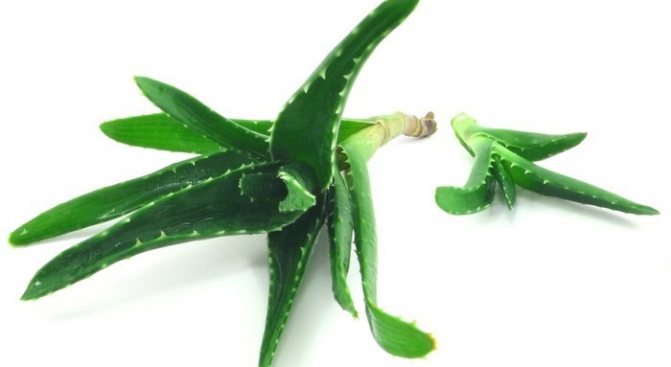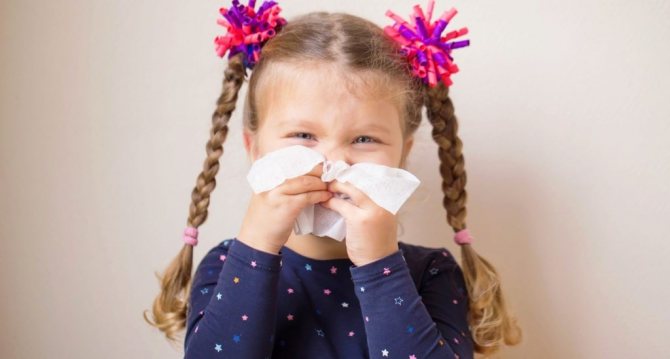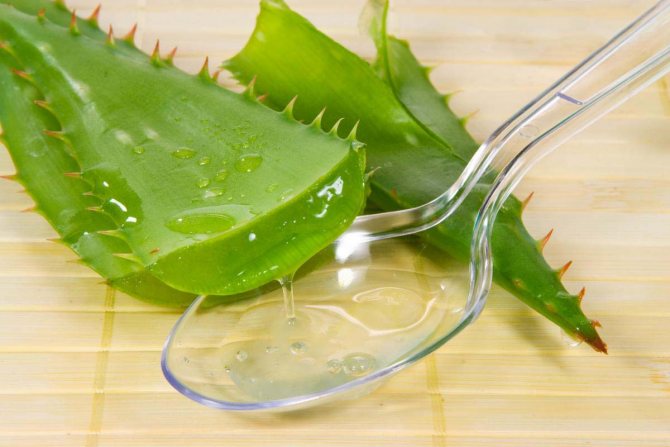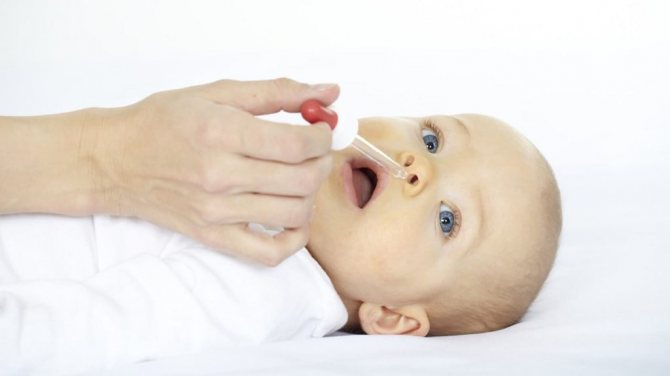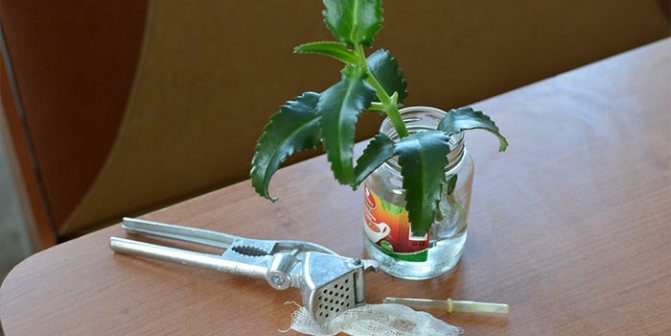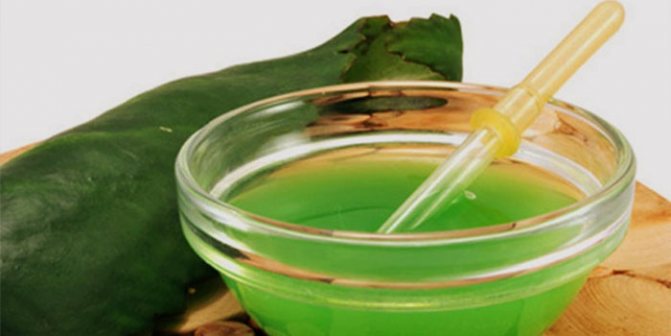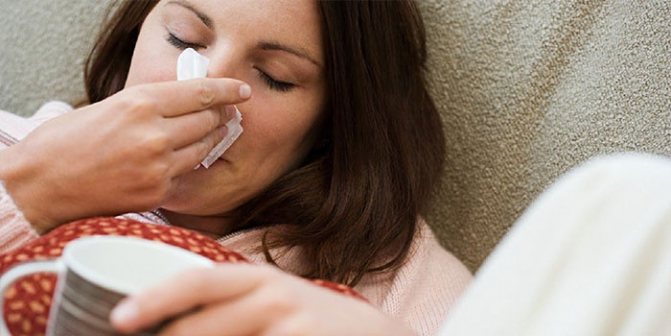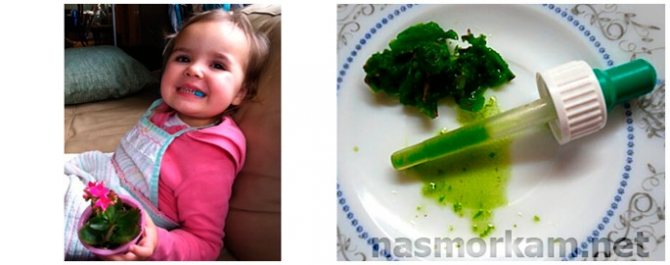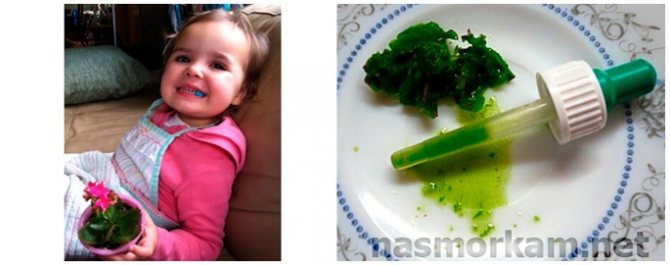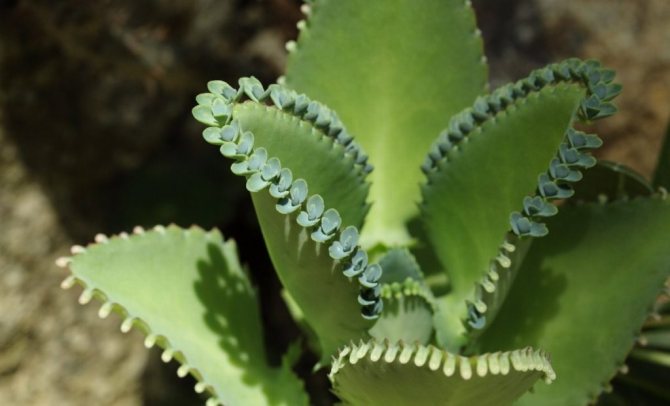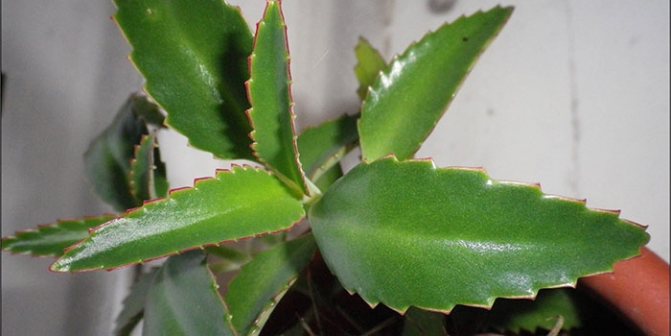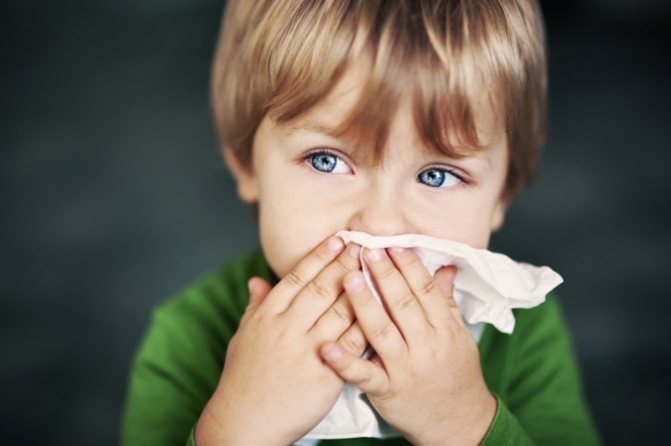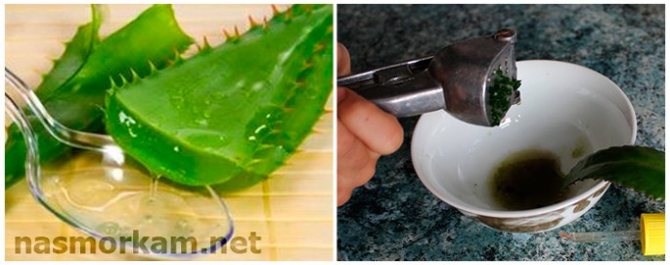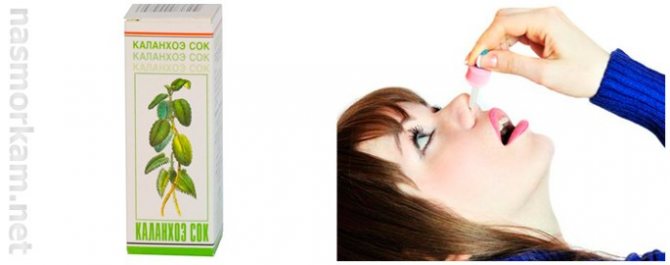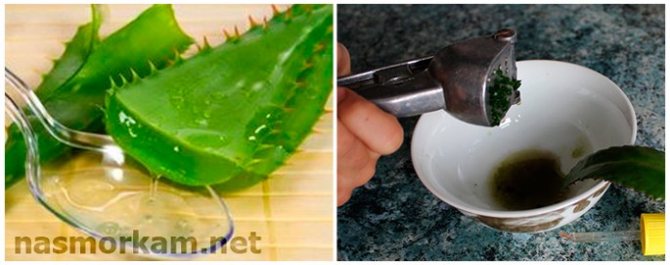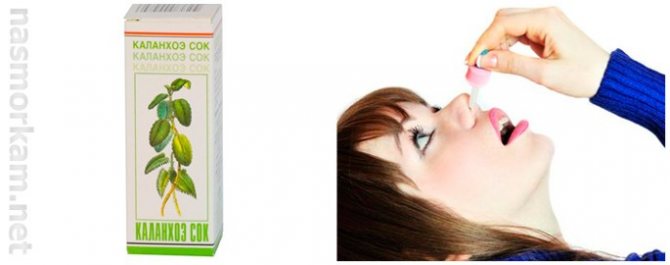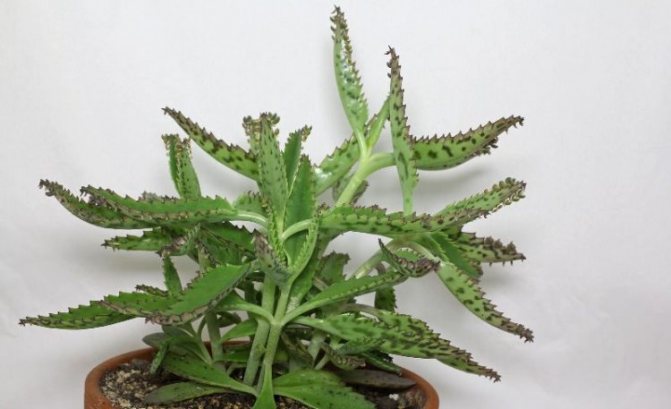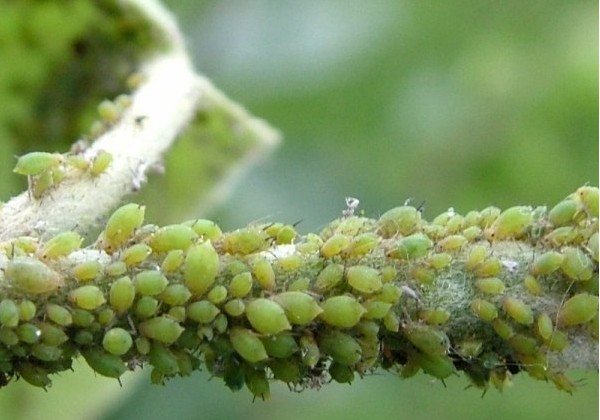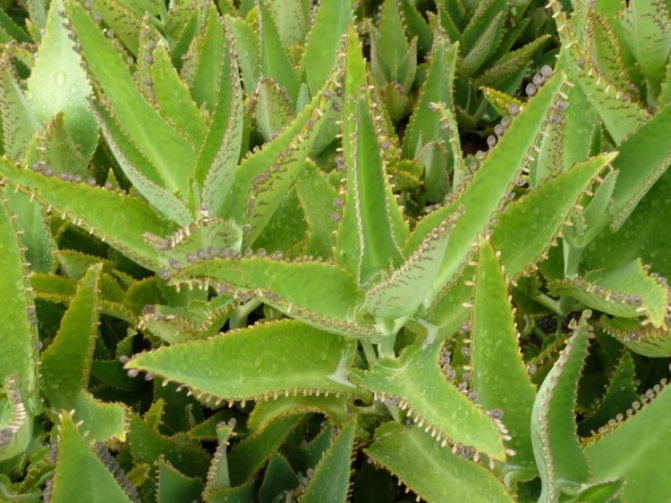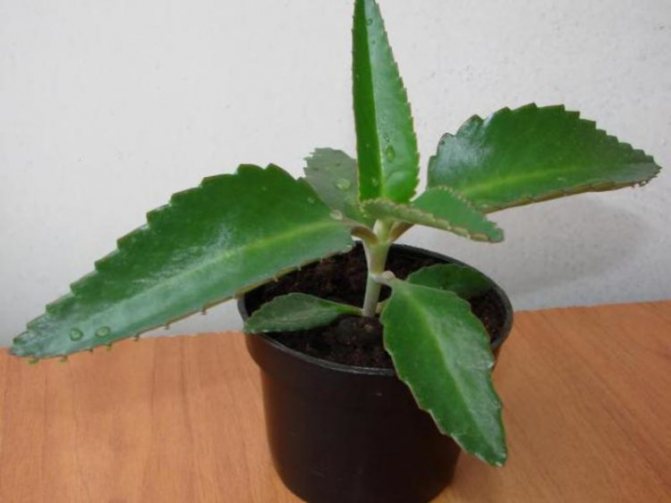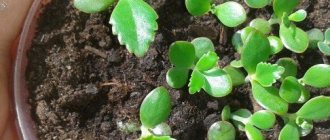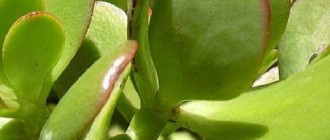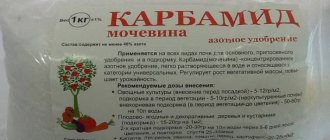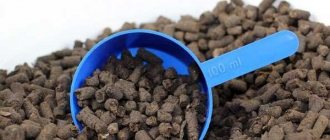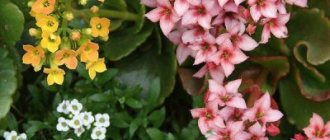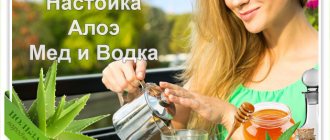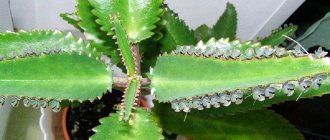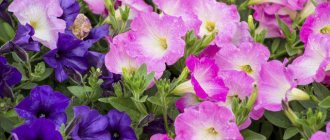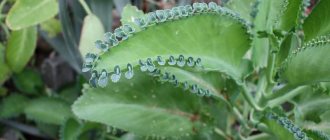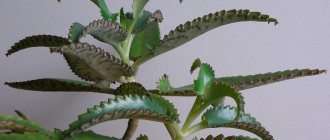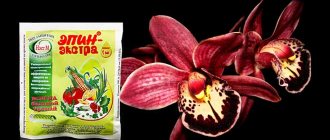Kalanchoe is a popular ornamental plant with a complex healing effect. Its juice and pulp are used in home remedies with antibacterial, anti-inflammatory and wound healing effects. Suitable for the preparation of drops, various infusions and ointments. Rarely causes allergies, side effects, therefore it is suitable for children and women during pregnancy. Recommended for the treatment of chronic or acute forms of sinusitis, treatment of the mucous membrane during the recovery period. Combines with traditional medicines as part of general therapy, other herbal ingredients.
Contraindications to the use of Kalanchoe juice with a cold
The specific effect of Kalanchoe on the human body (strong sneezing) determines a number of contraindications to the use of this plant for medicinal purposes. Firstly, it is not recommended to be treated with its juice for pregnant women in the last trimester, as well as those with a threat of miscarriage.
Secondly, Kalanchoe is contraindicated for infants up to a year. One of the reasons is the risk of developing otitis media. With active sneezing, which accompanies the procedure for instilling nasal juice, bacteria from the nasopharynx easily enter the ear. So the inflammatory process can develop.
In addition, a person may have an individual intolerance to the plant extract. Therefore, it is recommended to conduct a preliminary test before using the juice for medicinal purposes. For this, one drop of the drug is applied inside one nostril. If swelling, itching and other signs of allergies do not appear, then the remedy can be used.
Also, you should not use this method of treatment if you have problems with blood pressure - hypo- or hypertension. If the dosage of Kalanchoe juice is exceeded, the nasal mucosa may be burned.
Before starting treatment with this remedy, it is recommended to consult a doctor.
Kalanchoe during pregnancy
Most vasoconstrictor drugs can harm the health of a pregnant woman and her baby. Meanwhile, a stuffy nose also negatively affects the condition of the expectant mother: the child may not receive enough oxygen, not to mention the fact that the woman herself experiences significant inconvenience.

Kalanchoe can be used during pregnancy only after consultation with a specialist.
The permissible dosage of Kalanchoe juice during pregnancy is no more than 3 drops in one nostril. The course of treatment should not exceed 7 days.
In this case, the most acceptable option would be to use the most gentle folk remedies that relieve a cold. Kalanchoe juice quickly and effectively clears the nasal passages, but intense sneezing can tone the uterus. Therefore, use Kalanchoe juice during pregnancy only after consulting a specialist who will assess the current state of the body and weigh all the risks.
Instructions for the use of Kalanchoe juice for the common cold
The benefit of treatment with Kalanchoe juice lies, first of all, in the fact that the nasal passages begin to actively get rid of mucus. Therefore, for the duration of therapy, it is necessary to stock up on a considerable amount of handkerchiefs and it is recommended not to leave the house.
Instructions for Kalanchoe juice from the common cold for adults
Adult patients can use Kalanchoe juice in its pure form and in combination with other components for the treatment of rhinitis. The simplest method is to bury each nasal passage with fresh plant extract. It is enough to drip three drops into each nostril. The procedure can be carried out up to three times a day.
You can also take a cotton swab and moisten it with Kalanchoe juice. She needs to wipe the nasal cavity from the inside.
In addition, you can use homemade drops prepared according to one of the recipes:
- If you have a tendency to nosebleeds, weak blood vessels and increased sensitivity of the nasal mucosa, it is recommended to use diluted Kalanchoe juice. We mix it in a 1: 1 ratio with water. The solution is instilled into the sinuses three times a day, 2-5 drops.
- We mix equal parts of aloe and Kalanchoe juices. We drip 2-5 drops into the nasal passages at least twice a day.
- Squeeze the juice from the onion and Kalanchoe and mix them in a 1: 2 ratio. We bury the mixture in an amount of no more than two drops in each nostril three times a day.
How to use Kalanchoe juice for a cold for babies
Doctors advise using Kalanchoe juice with extreme caution to treat colds in infants. The concentrated extract can cause complications in young children. Therefore, if you nevertheless decide to apply this folk method of treatment, then you should not take juice, but a decoction of Kalanchoe leaves. At the same time, there is such a rule: the younger the baby, the lower the concentration of the substance should be.
The broth cleans the nose well of mucous secretions, and the effect is much softer than pure juice. Cooking it is quite simple: fill the leaves of the plant with cold water and put on fire. After boiling, remove from the stove and leave to infuse for one hour. The proportions should be selected independently. Optimally - a few leaves of the plant and half a liter of water.
It is necessary to bury the nose with a decoction in the same way as with juice - three times a day, a few drops in each nasal passage.
You can also prepare a mixture of aloe and Kalanchoe juices for babies. True, before use, they must be diluted with water at least twice. But you cannot use a mixture of onions and Kalanchoe to treat babies.
You can also soak cotton swabs in the juice or decoction of the plant and put them in the child's nostrils for a minute, if this will not cause severe discomfort in the little patient. For the prevention of colds and runny nose, children are advised to wipe the nasal passages with cotton swabs moistened with Kalanchoe juice (pure or diluted).
Pure Kalanchoe juice can be dripped into the nose for children over two years old.
How to use Kalanchoe juice from a cold bought in a pharmacy for children
If you do not have access to the Kalanchoe plant and cannot make juice from its leaves with your own hands, then you can purchase the finished product at the pharmacy.
Kalanchoe juice drops are produced by some pharmaceutical companies. They are inexpensive, but it is important to correctly determine their quality. For the treatment of the common cold, the extract must be clean. Alcohol solutions and various homeopathic remedies are not suitable.
When choosing Kalanchoe juice, check its concentration. In pharmacies, the so-called "stripped off" composition is sometimes sold. Its concentration is much higher than usual. Therefore, even adults cannot use it undiluted, otherwise it will entail side effects.
One hundred percent juice also needs to be diluted with clean water if you plan to bury it in children.
The medicine is used in the same way as homemade juice - 2-3 drops in each nasal passage three times a day.
Rules for the use of Kalanchoe juice from a cold during pregnancy
Pregnant women should be careful to use Kalanchoe juice for medicinal purposes. This is especially true for women who are in the last stages. You can not use the drug if the rhinitis is caused not by a cold, but by an allergy.
Before starting use, you should definitely consult with your doctor in order to weigh the need for such treatment.
Also, expectant mothers can use the following nasal remedy: mix in equal doses Kalanchoe juice, chamomile decoction and saline. We apply as usual nasal drops - three times a day. The maximum term of use is a week. After that, it is recommended to take a break from treatment.
How to prepare and apply nasal products
The Kalanchoe plant belongs to the jumbo family. It came to our homes from the tropics of Africa. In nature, there are more than 200 varieties of Kalanchoe, but no more than a dozen varieties are grown as indoor flowers, you must choose the right one. Only 2 types have healing properties: Degremona and feathery Kalanchoe.
The Degremona variety is one of the most common indoor plants. It has more vivid healing properties than the feathery variety, and is very active in reproduction. Buds grow around the entire perimeter of its leaves, and falling to the ground, they immediately take root, forming a new plant. The plumose variety Kalanchoe also has a healing effect on the body and differs from Degremona in lighter leaves.
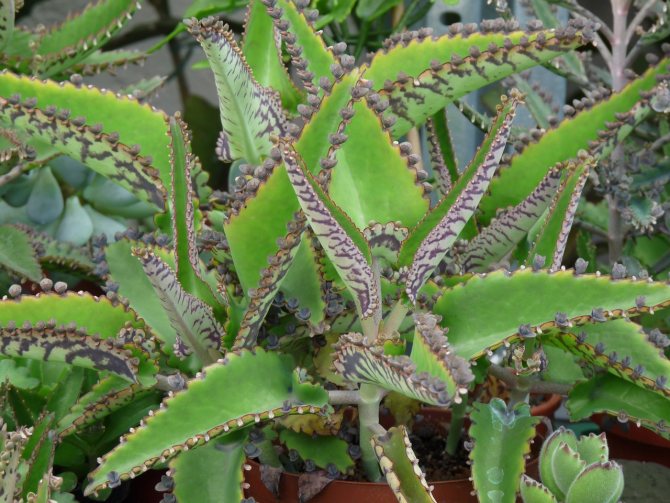

Kalanchoe Degremona has the most powerful healing properties
In order for the juice extracted from Kalanchoe leaves to have maximum healing power, several rules must be observed:
- use leaves only from plants older than 3 years: there are too few nutrients in the juice of young shoots;
- do not water the Kalanchoe 6-8 days before harvesting the leaves;
- collect only large and fleshy leaves that are not damaged;
- before preparing the drops, let the leaves rest for a week in the refrigerator: the lack of light and cold will make it possible to obtain the maximum possible concentration of nutrients.
From the leaves prepared in this way, juice can be squeezed out, which has a beneficial effect on the nasal mucosa. To do this, use a garlic press or chop the leaves and squeeze the juice out of them with cheesecloth. When doing this, try to avoid metal utensils by using wooden or ceramic objects.
Pour the resulting medicine into a clean bottle and use as needed. If the drops are intended for the treatment of children, you can immediately dilute them with boiled water in a 1: 1 ratio.
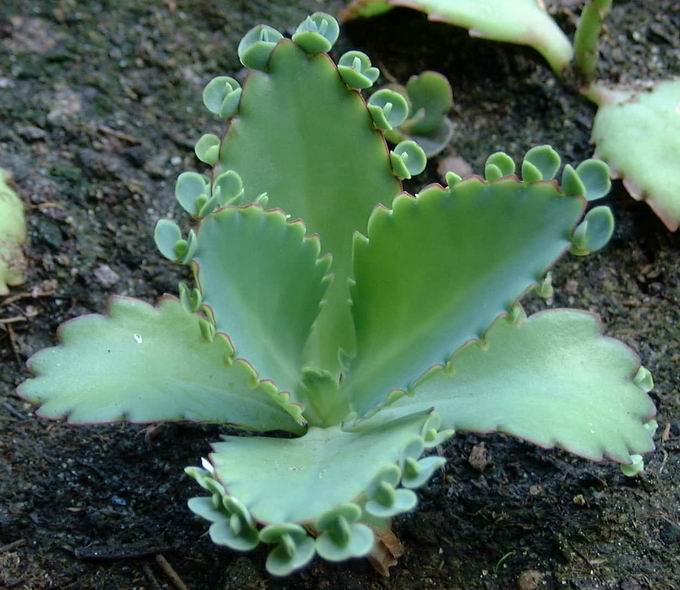

Kalanchoe pinnate differs from Degremona in lighter leaves
Do not try to prepare a healing liquid for future use: after about a day, Kalanchoe juice will lose its healing properties. Therefore, you need to prepare a fresh portion of nose drops daily.
Multicomponent Drops Recipes (For Adults)
Other components can be added to the juice extracted from Kalanchoe, which will enhance the effect of the medicine. The following recipes are used in the arsenal of folk healers.
- Kalanchoe and aloe. Mix fresh juice squeezed from aloe and Kalanchoe in a 1: 1 ratio and drip the liquid into your nose 3 drops several times a day. The drug can be kept in the refrigerator for about a day.
- Kalanchoe and onions. Coarsely grate the onion and squeeze the juice out of it. Mix 1 teaspoon of the resulting liquid with 3 teaspoons of Kalanchoe juice. You can keep the product in the refrigerator for about a day. Before use, be sure to test for sensitivity: onion juice can cause a burn to the mucous membrane, therefore, these drops are not recommended for children and sensitive people.
- Kalanchoe, lemon balm and St. John's wort. Pour 2 tablespoons of dried lemon balm leaves with a glass of hot water and simmer in a water bath for about 15 minutes. Prepare a decoction of St. John's wort in the same way.Cool, and then strain the resulting funds, then mix them with Kalanchoe juice in equal proportions. Before using the drops, do not forget to test for plant intolerance.
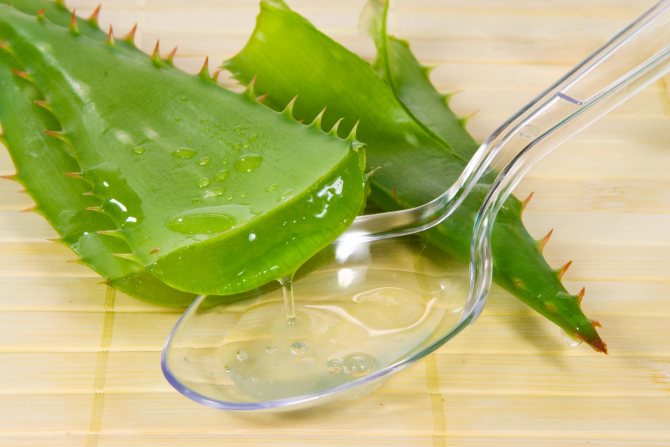

Aloe juice enhances the effect of Kalanchoe, but this combination can negatively affect the nasal mucosa.
Decoction
Undiluted Kalanchoe juice has a rather aggressive effect on the mucous membrane, so children under 2 years old should not use it. For the treatment of babies, a decoction of the "sneezer" is usually prepared. To do this, take 3-4 Kalanchoe leaves, fill them with 100 ml of water and bring the liquid to a boil. Remove the pot from the stove, cover and leave the broth for about an hour. After that, the healing liquid should be cooled, filtered, and then poured into a sterile bottle. The broth must be instilled 2 times a day, squeezing a couple of drops into each nostril.
Alcohol tincture
If you find it difficult to squeeze fresh juice out of the Kalanchoe every day, you can prepare an alcoholic tincture that retains the medicinal properties of the plant for about a year. Chop the Kalanchoe leaves aged in the refrigerator, put in a saucepan and leave in a cold place for a couple of days. Squeeze the juice out of the mass, measure out 200 ml and add 2 tablespoons of alcohol. Keep the solution in a cool place.
Inhalation liquid


Inhalation with Kalanchoe juice allows you to disinfect the entire nasopharynx
The juice from the Kalanchoe can not only be instilled into the nasal passages, but also inhaled with it. To prepare the solution, add 15 drops of plant juice to a glass of saline or salted water. The resulting liquid can be poured into a nebulizer or heated to no more than 50 ° C and placed in a warm-humid inhaler. After each use, the liquid must be poured out and a new portion of the medicine prepared.
Inhalations with Kalanchoe are not as effective as nasal drops, but they can be used as adjunctive therapy for respiratory diseases.
Ointment
On the basis of Kalanchoe, you can prepare an effective ointment, which is used to treat the nasal passages for the purpose of prevention or treatment. Melt 2 g of propolis and wax in a water bath, add 2 tablespoons of Kalanchoe juice. Mix 0.5 cups of vegetable oil with the same amount of liquid honey and 2 powdered mumiyo tablets. Then add a mixture of wax, propolis and Kalanchoe juice. You should have a creamy mass that can be stored in a cool place for 2-3 months.
How to make Kalanchoe juice at home
For medicinal purposes, the leaves of a plant that is more than three years old are suitable. In a young Kalanchoe, there is still not a sufficient amount of nutrients. However, it is the young plant that is intended for the therapy of babies, since it has a weaker effect.
Of course, when a runny nose appears, it is necessary to act urgently, so there may not be time to "lay down" the raw material. Most often, these leaves are used for the preparation of prophylactic drugs.
To get juice from Kalanchoe leaves, you need to wash them, cut them into small pieces and squeeze them in a garlic press. If the leaves are fleshy, then you can simply crush them with your fingers. This extract is not subject to long-term storage, and its concentration is quite high.
If as a raw material you use Kalanchoe leaves "laid down" in the refrigerator, then the juice from them can be kept for two days at a temperature not higher than 10 degrees Celsius. Also, the substance can be filtered and sterilized. Typically, such a drug is manufactured by pharmaceutical companies, and it can be stored for many years.
Before use, the plant sap must be warmed up in a water bath to room temperature.
How to use Kalanchoe juice - watch the video:
Kalanchoe juice is a popular folk remedy for combating a cold at home. It can be prepared easily by having a healthy adult plant on hand. Both adults and children can bury the nasal sinuses with the received drops. True, you first need to consult a doctor and conduct a small allergy test in order to avoid negative side effects.
A runny nose is a protective reaction of the body to irritants: viruses, bacteria and low air temperature. Experts say that in addition to taking proper care of a child during a cold, treatment is necessary. Many modern parents have already appreciated the effectiveness of folk remedies. In addition to being environmentally friendly and free of side effects, "Green doctors" strengthen the immune system and have preventive properties.
Which Kalanchoe is suitable for treatment
For medicinal purposes, not every type of this culture is suitable. Only Kalanchoe pinnate and Degremona have useful properties. As a rule, most of the ornamental varieties are bred from them; all maternal characteristics are preserved during selection.
To prepare home remedies, you need to choose an adult bush from 2 years old. You should carefully check the leaves and shoots - they should be dense, elastic and not show signs of decay. For 2 weeks from cutting the leaves, you need to abandon the application of fertilizing, and also reduce the watering regime as much as possible.
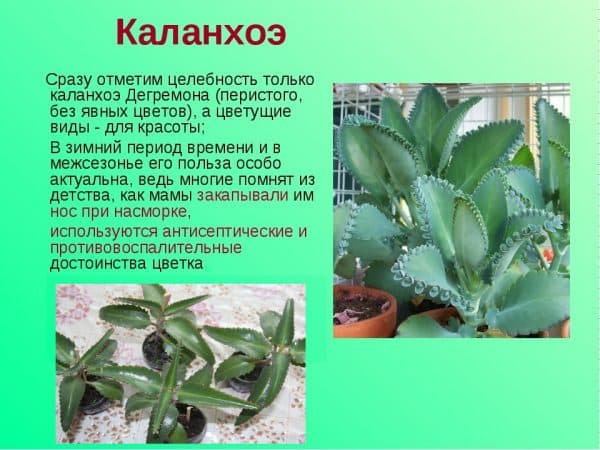

Whether they give a sick leave for sinusitis, this article will tell you.
Plant preparation
In some pharmacies, Kalanchoe juice can be purchased in the form of small bottles with a capacity of up to 100 ml. However, in practice, it is obtained independently from a house plant. Step-by-step algorithm for the preparation of useful raw materials:
- Choose a healthy and mature plant, carefully check it from all sides.
- With a sharp knife, cut off 2-3 bottom leaves together with the shoot.
- Rinse with cold water, dry completely.
- Put in the refrigerator for a week, wrapped in a paper napkin.
- Remove the skin, grind until smooth.
- Squeeze the juice with cheesecloth into a glass container with a lid.
Juice can be stored ready-made for no more than a day; before cooking, it must be warmed up to room temperature. Sediment may appear, which is normal. It usually dissolves with gentle agitation.
Pharmaceutical preparations based on Kalanchoe juice or pulp contain chemical stabilizers and preservatives. They allow you to extend the shelf life without losing useful qualities.
The benefits of Kalanchoe for children
Kalanchoe has a number of medicinal and immunity-strengthening properties. The plant is especially wide use for rhinitis.
The name itself indicates that the plant was brought from the tropics. There are about 200 types of flowers and only two of them are medicinal. Degremona and over-grown Kalanchoe are used for medicinal purposes.
Green leaves with a grayish tint in the shape of a triangle are Degremona.
A distinctive feature is the ability to multiply by leaf buds that grow along the edges of the triangle. Retired Kalanchoe has a light green tint and a similar appearance. But in terms of properties, it is significantly inferior to Degremon. These types are the most common in our country. The plant does not require special care and is found on almost every windowsill.
Good to know: the plant contains a large amount of vitamin C, rich in trace elements, organic acids and flavonoids.
Kalanchoe has different names: "tree of life", "home doctor", "indoor ginseng" and "sneezer". Such properties of the plant as wound healing, anti-inflammatory, bactericidal, cleansing and immunostimulating can treat various diseases. With mucous secretions and rhinitis, the plant has no equal.
In cases where the child cannot blow his nose or does not allow his nose to drip, Kalanchoe is the most convenient and painless treatment option.
Important: when using the juice of the plant, a complete cleansing of the nasopharynx occurs. After a few drops, your baby will start sneezing and all the accumulated mucus will come out.
The juice of the plant is used with extreme caution, especially for children. High concentrate can burn your baby's sinuses.
Not to be confused with aloe
The juices of these plants have different effects, when treating a cold it becomes absolutely obvious. Aloe acts in the direction of healing the inflamed nasopharynx, its restoration. Kalanchoe (Degremona or feathery) radically and quickly cleans the nasal passages.
The mechanism of action of aloe is different, but they are combined, interspersed with each other, used for other ailments.
Aloe does not bloom in indoor conditions, and Kalanchoe has flowers, it is also decorative.
It is better to have both of these wonderful plants at home, then not only an exotic landscape on the windowsill will be provided (both species, feathery and Degremona, are very beautiful), but also a reserve of unsurpassed medicines.
In addition to the mentioned feathery and Degremona, there are other types of Kalanchoe. Some of them also have medicinal properties, but are much less common and less studied.
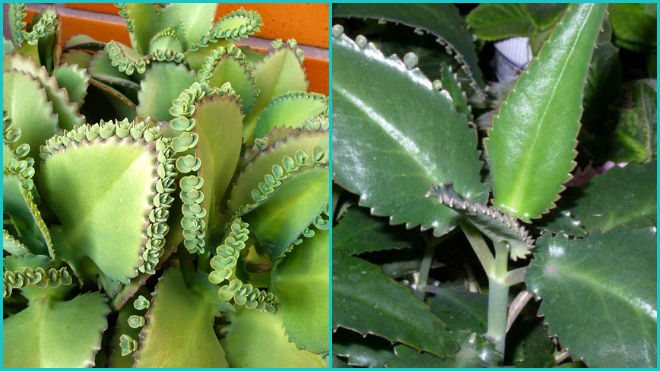

Treatment of a common cold in babies using Kalanchoe
Before applying the healing property of the plant to treat a child, consult your doctor and test for yourself.
Kalanchoe can cause allergies.
Kalanchoe juice, a decoction of leaves, tincture and solution are used for children of different age groups.
Important: a decoction of the plant is useful for infants and toddlers up to 2 years old. The younger the child, the lower the concentration of the active substance.
To prepare a mild agent, you will need two medium Kalanchoe leaves and 100 ml of water. Add the leaves to boiling water and leave for 2 hours. You need to start with a minimum dose: dip a cotton swab in the solution and clean the baby's nose. After a few hours, use one nose drop at a time.
For children 2 years and older, plant juice is best suited.
There are several ways to get it:
- If you come across a fleshy leaf, then you need to press hard at the cut site and you will receive an average dose for the child.
- Using cheesecloth, squeeze the crushed leaves into a special container.
Freshly squeezed juice is effective for treatment.
The leftovers are recommended to be stored in the refrigerator and warmed to room temperature before use.
To eliminate a runny nose, children are buried 1-2 drops for each nostril up to 3 times a day.
For children under 2 years old, the juice is diluted in half with water.
It is very convenient to use cotton swabs dipped in Kalanchoe juice. Place them in each of your baby's nostrils for a few minutes. The result will not be long in coming.
A mixture of Kalanchoe with aloe in equal proportions is more effective. The resulting liquid is dripped into the nose, 1 drop into each nostril.
For preventive purposes, during an epidemic, the baby's nose is treated with Kalanchoe juice. It is enough to moisten a cotton swab and clean the nasal passages 2-3 times a day.
It is important that the temperature of the product is at room temperature. Leaves
it is recommended to take from the plant
at least 3 years old.
The cut Kalanchoe is wrapped in paper and kept in the refrigerator for three days. This tincture will have high medicinal properties. If you cannot expect, then you can use fresh raw materials.
After application, the baby will begin to sneeze.
, so get handkerchiefs ready and follow the baby's position.
Modern medicine makes extensive use of the healing properties of the plant. Therefore, in any pharmacy you can buy Kalanchoe juice, tincture or nasal drops in plant extract. But the use of a "home doctor" gives one hundred percent confidence in its quality.
How to properly treat a runny nose in children
According to Dr. Komarovsky, it is not worth treating rhinitis in children in the first 3 days: the produced mucus is necessary for the body to repel the attack of viruses or bacteria. As for the Kalanchoe juice, this remedy helps some children well, but does not affect others or provokes complications.


For babies under 2 years old, only Kalanchoe broth can be instilled into the nose
Whether or not to use Kalanchoe to treat babies is up to the parents to decide. If you nevertheless decide to use folk recipes, do not forget about the rules for using this plant in pediatric practice.
- Babies under 2 years old can only drip a decoction into the nose: drop by drop twice a day.
- For children under 5 years old, juice diluted with water is usually instilled (2 drops a couple of times a day) or turundas soaked in liquid are inserted into the nasal passages. Before this, it is imperative to conduct a test for individual intolerance to the drug.
- When treating children, only pure Kalanchoe is used without the addition of aloe juice, onions and other components.
- Do not use Kalanchoe juice if the child has a temperature above 37 degrees.
- Do not add a new dose of juice if the effect of the previous dose has not yet expired and the child continues to sneeze.
- Kalanchoe juice can be instilled into the nose of children for no more than 5 days.
- If a rash or other adverse reaction occurs, stop using the drug immediately.
Kalanchoe juice is effective only for bacterial and viral infections: do not try to cure allergic rhinitis or physiological rhinitis of newborns with it.
Side effects when using Kalanchoe
Kalanchoe has no side effects
, if you follow all the rules of application. But with the wrong dosage, an allergic reaction and burns of the nasal mucous membranes can occur. Therefore, consultation with a specialist is required.
Important: to begin with, use only a solution of the plant in equal parts with water. Follow the baby's reaction after 2-3 hours. If a rash or difficulty breathing occurs, treatment should be discontinued.
For children under 2 years old, the broth or infusion is also diluted in equal parts with water. The effect is the same, but the effect on the mucous membrane of the nose is milder.
Kalanchoe is very convenient and effective to use. But the opinions and experiences of many parents differ. In most cases, the plant instantly clears mucus from the entire nasopharynx and prevents new ones from forming. Some parents complain that the plant does not give the desired effect and the runny nose does not go away. In this case, the concentration and dose of Kalanchoe must be increased.
Application of Kalanchoe can become or chronic rhinitis. Therefore, it is so important to listen to the opinion of the pediatrician, who will select the right form and dose for your baby.
The wide range of remedies for the treatment of the common cold has a clear drawback. Almost all drops based on chemical components do not cure, but dry the mucous membrane of the nose. Kalanchoe is a gift of nature, a remedy that can both heal and prevent infection. What is the best for the growing body of your baby.
Risks and Potential Consequences
Like other herbal medicinal plants, Kalanchoe can cause various side effects. With an increased concentration of the working solution or abuse of treatment with such a remedy, burns and irritation appear on the mucous membrane. The process of mucus secretion is enhanced, therefore, it is additionally recommended to use vasoconstrictor drops.
The plant can cause allergies and mild poisoning, be sure to check the body's reaction before using it for the first time. From therapy with this method, you need to be when a rash appears on the skin, a feeling of congestion, severe burning and nosebleeds.
Whether it is possible to go to the bathhouse with sinusitis, you will find out here.
The healing properties of Kalanchoe
Kalanchoe is a house plant that has very beneficial properties.Due to its composition, the extract of this medicinal flower is used in many medical preparations. The benefits of Kalanchoe are obvious: its properties help to quickly remove a runny nose in both adults and children. It contains:
- micro and macro elements;
- acids;
- organic and tannins;
- vitamins;
- alkaloids.
Such a rich composition of nutrients explains the popularity of the plant in medicine. The extract from the leaves helps not only with a runny nose and irritations of the nasal mucosa, but is also often used in the treatment of ulcers, various inflammations, toothache, varicose veins and other ailments. On the basis of a healing flower, tea is made that relieves sore throat. The most common use of the herb is to combat nasal congestion. For this, two types of plants are used: degremona and pinnate.
Useful properties of Kalanchoe juice
A runny nose is a protective reaction of our body against the invasion of foreign microorganisms. The mucus that accumulates in the nose is an excellent breeding ground for bacteria. That is why rhinitis is treated exclusively by washing: constant debridement of mucus accelerates recovery and prevents various complications from developing.


A runny nose is not an annoying symptom, but a protective reaction of the body
The Kalanchoe people are called home doctors, the tree of life and even indoor ginseng.
Various sprays and nasal aspirators can be used to remove mucus from the nose. There is another, easier way - to drip Kalanchoe juice into the nose. This plant has the ability to induce an indomitable sneeze in a person, as a result of which all mucus flies out of the nose - even that which cannot be removed mechanically. For this ability, the inhabitants called the Kalanchoe "sneezer" and began to intensively use the plant to treat rhinitis in both adults and children.
Kalanchoe juice is not just a liquid that irritates the nasal mucosa. It contains a whole range of nutrients:
- vitamin C - has a pronounced immunomodulatory effect;
- flavonoids - protect the body from negative external influences, strengthen immunity, relieve inflammation;
- tannins - have hemostatic, astringent and antimicrobial effects;
- enzymes - regulate the metabolism in the body;
- organic acids - have a bactericidal and choleretic effect;
- macro- and microelements - stimulate redox processes, activate muscle activity.
In other words, Kalanchoe juice has antihistamine, bactericidal, stimulating, immunomodulatory and anti-inflammatory effects. This liquid not only effectively removes mucus, but also disinfects the nasal cavity, making the runny nose heal much faster.
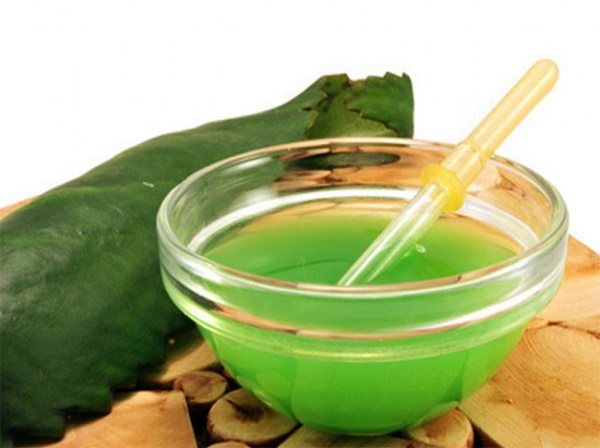

Kalanchoe juice is a real storehouse of nutrients
The juice extracted from the Kalanchoe should be used in cases when:
- a person with rhinitis has persistent nasal congestion;
- discharge is yellow or greenish;
- other remedies for the common cold do not help (including medications);
- the patient is not allergic to Kalanchoe juice.
It is possible to determine whether a person has an individual plant intolerance as follows. Apply a drop of juice to the crook of your elbow or place it under your nose. If after 1.5-2 hours the place of application is not reddened or swollen, you can try to drip the juice diluted with water into each nostril. After that, wait a couple of hours, and in the absence of negative reactions, feel free to use the recommended age-specific dosage.
Video about the medicinal properties of the plant
Kalanchoe rhinitis treatment
Kalanchoe juice from the common cold is often used in its pure form. The liquid released from the leaves of the plant has a high anti-inflammatory effect.The procedure for using the product is simple - you need to apply the extract to a cotton swab or tampon, and then wipe the nasal cavity. Doctors do not advise to carry out such a procedure more than three times a day, since there is a possibility of damage to the mucous membrane. You should not use Kalanchoe in its pure form to treat babies, since the reaction of the baby's body to the juice is not predictable.
On the shelves of pharmacies, you can often find another form of Kalanchoe - drops that are produced by various pharmaceutical companies. They are widely used to get rid of the common cold in adults and children. But doctors recommend approaching the treatment of complications (sinusitis, sinusitis) individually, after preliminary consultation with a specialist. A broth based on plant juice and other additives (onion extract, St. John's wort or aloe) has a milder effect. This form is safe even for a child's body.
In adults
It is easy and simple to treat a runny nose in an adult with the help of Kalanchoe. The most effective method of using the juice of a medicinal plant is to use it in its pure form. Drops based on a medicinal flower are buried in each sinus 2-5 drops four times / day. People prone to nosebleeds should use the product carefully. The juice obtained from the leaves of the healing flower can cause violent sneezing and excessive mucus production. These factors contribute to the manifestation of bleeding.
In this case, a softer, but no less effective solution should be prepared. For example, a homemade onion recipe:
- Cut off a fresh Kalanchoe leaf and rub until the healing liquid is released.
- Repeat the process with the onion head.
- Mix onion and flower juice (one to two).
- Must be taken three times / day, but no more than 1-2 drops.
- After a month, repeat the procedure for prevention.
In children
Doctors advise treating a runny nose in babies with a decoction of the leaves of a self-made healing flower. The use of the product in its pure form threatens with severe irritation of the mucous membrane. It is necessary to act according to the principle: the younger the child, the lower the concentration of the decoction should be. The medicine will help to safely clear the baby's nose of excess mucus. Drops for a cold for children from a year are prepared as follows:
- Place the flower leaves in cold water (using a deep bowl).
- Put the mixture on fire and bring to a boil.
- Let it brew for at least one hour.
- It is necessary to drip three times / day.
During pregnancy
Kalanchoe is a useful and harmless flower, however, during pregnancy, the extract should be used with extreme caution. The danger is that when using the medicine for the common cold, intense sneezing occurs. Due to this natural process, the abdominal muscles are overly tense, which can harm the fetus in the womb. According to the instructions, such a remedy for the common cold for pregnant women is not used.
Traditional medicine in the treatment of children is preferable to aggressive drugs. However, it is impossible to use herbal remedies without consulting a doctor. Self-medication is especially dangerous in early childhood. Due to allergic reactions, the child may develop choking. But such boards are exceptional, usually children tolerate home remedies well and recover quickly.
So, Kalanchoe is considered an invaluable plant. They are treated for dermatological diseases and colds. It is recommended to use Kalanchoe for the common cold for children if the rhinitis is non-allergic. But before using the plant juice, you should make sure that there are no contraindications.
The plant has regenerating, disinfecting and anti-inflammatory properties. It has found wide application in ENT practice and dentistry. You can use the juice not only for a cold, but also for other diseases of the nasopharynx: tonsillitis, sinusitis, inflammation of the adenoids.
What medicinal properties of Kalanchoe help children with a cold? The herbal product has a decongestant effect, cleanses mucous membranes and improves nasal breathing. All this is facilitated by the unique composition of the juice:
- flavonoids - activate metabolic processes at the tissue and cellular level;
- tannins - show bactericidal, anti-inflammatory and disinfectant activity, sanitize the nasal cavity and prevent nosebleeds;
- enzymes - participate in tissue metabolism, accelerate the rate of decomposition of substances;
- organic acids - the product is enriched with acetic, oxalic, malic acids. They have an anti-inflammatory effect, normalize local blood circulation, and increase local immunity.
The plant is rich in polysaccharides and mineral compounds. The composition also contains local irritating components and natural immunity activators.
The high content of trace elements and vitamins in the juice contributes to an increase in barrier functions and reduces the likelihood of complications from colds.
The phytopreparation is actively used against the common cold in children and for other reasons. It is a safe and effective product that allows mucus to drain, cleanses the nasal passages, and prevents the development of bacterial rhinitis. When exposed to receptors, sneezing begins, as a result of which the secret leaves more actively, and nasal congestion disappears.
How the plant will help with sinusitis
Kalanchoe is useful for treating sinusitis due to its antiseptic effect and the ability to relieve puffiness. Helps relieve inflammation, which is a key symptom of the disease. The sap of the plant irritates the cells of the mucous membrane, due to which the mucus liquefies and its active management. Nasal breathing is normalized, and the rate of infectious processes slows down.


During the course of treatment, vasoconstriction occurs, and the process of restoration of the affected cells is accelerated. The juice or pulp of the leaves can be used in its pure form, but for enhanced action they are combined with other natural ingredients - aloe, honey or chamomile decoction. These ingredients are also used to combat sinusitis coughs.
Homemade medicinal prescriptions are a complementary treatment. In terms of their effectiveness, they are significantly inferior to drug therapy.
Chemical composition
The beneficial properties of Kalanchoe are due to the rich chemical composition of its juice. The pulp contains:
- organic acids - oxalic, malic, acetic;
- tannins;
- micro and macro elements;
- vitamins of group C and K;
- plant enzymes;
- flavonoids.
The content of these components varies depending on the age of the bush, the characteristics of care and the time of year. It is believed that it is advisable to take leaves for making home remedies during the growing season from spring to autumn.
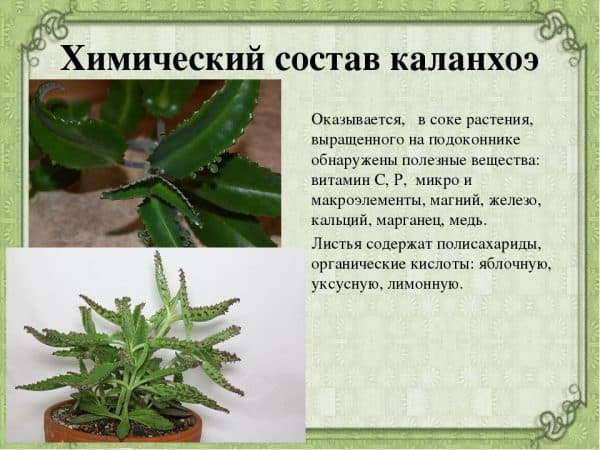

What is the difference between sinusitis and sinusitis this material will tell.
Indications for use
Various decoctions, drops and infusions from Kalanchoe are actively used to treat simple forms of sinusitis, as well as during recovery and prevention. The plant copes with congestion, has a weak antibacterial effect, therefore it is often recommended as part of the therapy of infectious types of inflammation. Helps with a large amount of discharge, long-term disease and discomfort. Strengthens the process of regeneration of epithelial tissues, which is useful in the postoperative period. It can be used for small children, during pregnancy and lactation, if there is no individual intolerance to the components of the composition.
Contraindications
The plant in any form cannot be used with increased sensitivity of the body, since the active substances in the composition can irritate the mucous membrane. Relative contraindications:
- high temperature with sinusitis, chills;
- chronic diseases of the respiratory system;
- allergy;
- congenital or acquired pathologies of the heart, kidneys and liver;
- age up to 3 years.
It is recommended to consult your doctor before use. Despite the weak effect and the mild effect of folk methods, they can cause severe complications - dermatitis, an attack of allergies and irritation of the nasal mucosa.
Before preparing the tincture or drops, you should check the body's reaction to the juice. To do this, a small amount of the product on the skin of the elbow, wait 30 minutes.
Indications for use
Fans of herbal medicine leave positive reviews about Kalanchoe in relation to the treatment of children's rhinitis. If the plant is used wisely, the positive effects will appear quickly. Indications for the use of plant materials are:
- lingering rhinitis of a non-allergic nature;
- persistent nasal congestion;
- bacterial rhinitis, as evidenced by a greenish discharge with an unpleasant odor from the nose;
- inflammation of the adenoids;
- children's polyposis;
- sinusitis and sinusitis of the upper sections.
It is important to be sure of the diagnosis before starting therapy. A seeming cold runny nose can be triggered by allergies or teething. You should not use Kalanchoe "just in case". The phytopreparation should be taken as seriously as any other medicine.
Precautions for children and adults
Before you start using Kalanchoe for a cold, you need to make sure that there is no individual intolerance (and other contraindications). To do this, lubricate the skin under the nose with a product and wait one and a half to two hours. If redness, itching, swelling, and other noticeable reactions of the body do not appear, the medicine can be applied nasally. If the listed signs are present, you need to take an antihistamine and look for another remedy. Tolerance tests should be done on aloe if they are to be used together.
Nevertheless, for a start, it is better to dilute Kalanchoe juice and drip a little, no more than 1 drop into each nostril. This caution is due to the fact that the sensitivity of the mucosa must also be tested in small doses. Careless use of the drug can lead to burns.
The presence of injuries, wounds, cracks in the mucous membrane, the occurrence of a burn are contraindications to the use of Kalanchoe juice, at least until healing.
The juice used should be at room temperature.
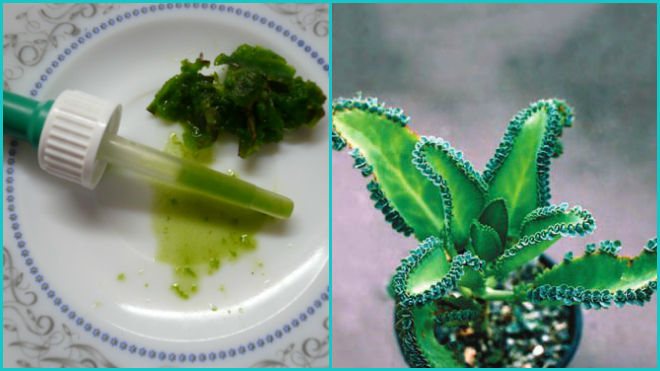

Contraindications and precautions
In early childhood, pure juice is not used. The agent is quite aggressive and can irritate the baby's mucous membranes. A decoction of the plant is capable of replacing freshly squeezed juice. It has a lower concentration, but retains its beneficial properties. Not knowing how to treat a runny nose in a Kalanchoe child can harm the health of the baby. Up to two years, the drug is used in a diluted form. Juice is strictly prohibited even in the absence of allergic reactions.
In order not to harm the child, you should be treated correctly:
- do not use Kalanchoe earlier than the third day of a cold;
- abandon Kalanchoe therapy for allergic and vasomotor rhinitis;
- before treatment, carry out an allergy test - apply a drop of juice to the inner surface of the elbow and wait 1-2 hours;
- do not carry out herbal treatment for more than 5 days.
The dosage of the drug is selected taking into account the age of the child. The same applies to the regularity of the procedures. Babies under 1 year old are given a strong broth of Kalanchoe diluted in half with a frequency of 2-3 times a day, 1 drop. Babies from 1 to 3 years old are offered the same dosage 3-4 times a day. Children from 3 to 6 years old can bury the juice diluted in half, 3 drops in each nostril 4 times a day. From the age of 6, it is allowed to use undiluted Kalanchoe juice.
What to do with juice
The use of the juice does not require any effort, the recipes for the treatment of a stuffy nose are very simple:
- lubricate the inner surface of the nose;
- small tampons are dipped in Kalanchoe juice, placed in the nostrils for a short time, repeat several times until improvement;
- drip fresh juice, 1-2 drops into each nasal passage;
- mix equally aloe juice, onion juice and Kalanchoe juice.
Dripping two drops a day. You can use the same recipe, but without the onion juice. At high sensitivity, it can be diluted with water. This recipe is not suitable for a child, even if the composition is diluted with water.
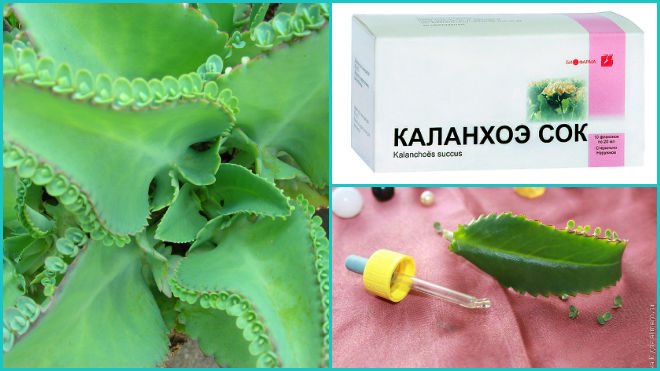

How to prepare raw materials for treatment
An adult plant has healing properties, however, the juice obtained from old leaves can be too concentrated and aggressive for a child. Plants up to 3 years old are usually used. During this time, Kalanchoe manages to gain useful substances with high bioavailability.
The lower leaves are cut off, which, if dirty, are washed or wiped with a dry napkin. Like aloe, the plant is kept in a cool, dark place for up to a week. If you can't stand time, then the leaves are sent to the side compartment of the refrigerator for 2-5 days.
Prepared stems and leaves are crushed, squeezed and the resulting juice is defended until sediment appears. After the raw material is re-filtered. You can store the juice in the refrigerator for up to 7 days. It makes no sense to procure medicine for future use. It is best to extract the juice directly from the leaf. A child does not need a lot of the drug - one leaf of Kalanchoe is enough for a 3-day treatment. Then the juice is diluted with water and used as needed.
How to get juice
The juice of the plant is used, which is very easy to obtain at home by squeezing it out of the leaves. You can chop a few leaves and squeeze them in gauze.
It is also common practice to extract juice from leaves that have been kept in the cold. The leaves are placed on the bottom shelf of the refrigerator for 7-10 days, wrapped in dark paper or cloth. Being in extreme conditions encourages plant cells to produce substances that enhance its medicinal properties.
The health of the leaves depends on the age of the plant. A plant is considered mature from three years, but you can not wait three years and use young leaves. They are especially recommended for children, the concentration of active substances in such leaves is lower, and there are medicinal properties, although they are less pronounced, which is better for sensitive mucous babies.
Usually the lower leaves are cut, they have more active substances. When treating young children from a cold with a Kalanchoe solution, it is better to take the upper leaves, their effect is much milder.
Before cutting off the leaves, it is recommended not to water the Kalanchoe for several days. If you do not have time to wait, you need to squeeze the juice from freshly cut leaves without preliminary action, using your hands or a regular garlic crusher. However, it should be borne in mind that not everyone can withstand the procedure of instillation with fresh undiluted juice - you can get a burn of the mucous membrane. The juice is usually diluted with water at room temperature in equal proportions, or with less juice. The resulting solution is used as usual drops: it is injected into the nostrils 2-3 times a day until the condition is relieved. Ready juice can be purchased at a pharmacy, use only diluted, in the indicated proportions.
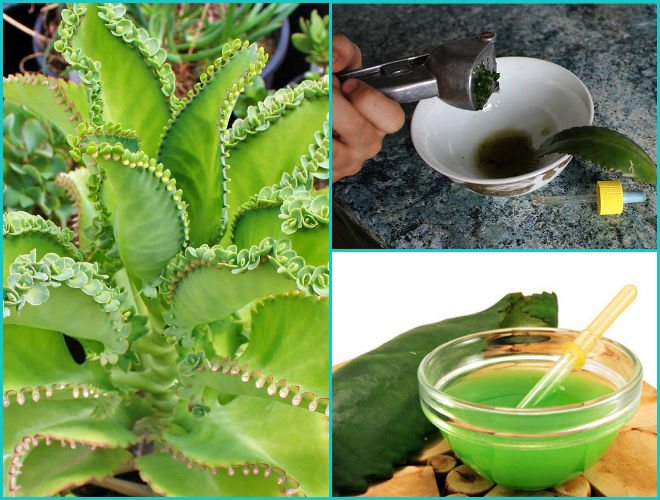

Effective recipes
For children under one year old, a decoction of the plant is suitable, which is prepared as follows: take 500 ml of boiling water per 100 g of leaves, keep it on fire for 20 minutes, cool, filter. If the child tolerates the decoction of the plant well, then there is no need to dilute the medicine. Before treatment, the nose is washed with salt water, and then 1-2 drops are injected into each nostril.
The child's reaction to Kalanchoe is an attack of sneezing. Do not be alarmed if your child sneezes loudly and often. So it clears the mucous membranes and gets rid of the infection.
In its pure form, Kalanchoe is not used for a cold in children under one year old. You can dilute the plant with plain water or saline. The second option is preferable.The ingredients are mixed in equal proportions, and the resulting mixture is instilled into the nasal passages, or soaked in cotton turundas and put into the nose for a short time. Saline has cleansing and disinfecting properties and reduces swelling.
With honey
Traditional medicine recipes offer different ways to treat Kalanchoe infant rhinitis with honey. Both components are allergenic, therefore, it is undesirable to use them to treat children under 3 years of age.
It is worth preparing a medicinal ointment for a bookmark in the nose. For this purpose, take 50 g of petroleum jelly, 30 g of Kalanchoe and half a teaspoon of honey. Mix well and use for impregnation of cotton turundas. You can lubricate the nasal cavity with ointment from the inside.
Treatment of rhinitis in Kalanchoe children with honey will be more effective if you add onion juice and cyclamen root to the recipe. All ingredients are taken in equal parts. If you add a little Vishnevsky ointment, you get an effective drug for sinusitis. A thick mixture is placed in the nostrils for 15-20 minutes. This treatment is suitable for older children.
In case of polyposis, drops from Kalanchoe and onion juice with the addition of liquid bee honey and an aqueous extract of propolis will bring benefits. The drug helps to relieve puffiness, disinfects mucous membranes and inhibits the growth of polyps in the nose.
With aloe
A mixture of aloe and Kalanchoe juices is considered a powerful antiseptic and bactericidal. In its pure form, the product is allowed to be instilled into the nose of a child from 6 years old. It is impossible to use aloe and Kalanchoe for a cold in an infant, even in a diluted form.
. The plant helps in the fight against rhinitis
(we talk about the peculiarities of using Kalanchoe for the treatment of children's rhinitis in). Drops are prepared from it for instillation into the nose, and they wipe it inside with juice to protect themselves from infections in crowded places or during epidemics.
What medicinal properties does it have:
- powerful anti-inflammatory effect;
- bactericidal effect;
- antibacterial action;
- wound healing effect;
- cleansing the blood and removing harmful substances from the body;
- hemostatic effect.
To gain strength, cheer up and wake up, you need to stand or sit near the pot with the plant for at least 5 minutes.
When applied
A very effective remedy for the common cold, albeit a peculiar one. When treating with Kalanchoe juice, unrestrained sneezing begins, as a result of which the nasal passages and sinuses are cleared, breathing is greatly facilitated. Helps Kalanchoe with a runny nose and sinusitis, with inflammatory processes in the nasopharynx. It is dripped for prophylaxis in the cold season and off-season, then treatment is simply not needed. In addition, it has pronounced stimulating and tonic properties.
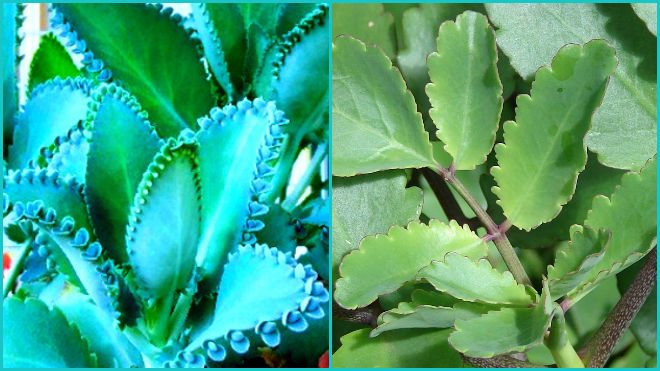

Can alcohol juice be instilled?
Into the sinuses
Any alcoholic tincture without dilution with water in a 1: 1 ratio is not suitable for instillation in the nose or eyes. The resulting product is used to flush mucus from the sinuses.
In the ear cavity
Kalanchoe alcoholic juice without dilution is used for inflammation of the middle ear
... It is prepared like this:
- Take 2 tbsp. l. crushed plant leaves and 200 ml of 40 percent alcohol.
- Mix the ingredients and leave in a warm room for ten days, tightly closed with a lid.
- After ten days, the tincture is ready for instillation into the ear.
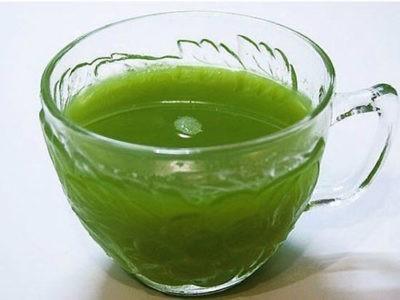

Unused leaves of the plant are wrapped in paper and put in the refrigerator.
... The shelf life is 5-7 days. After this period, they lose their medicinal properties.
Photo
Next, you can see a photo of the Kalanchoe plant, which has medicinal properties for the common cold.
Pharmacy drops
The pharmacy sells a finished preparation based on Kalanchoe for local and external use. It is released without a prescription at an affordable price (86 rubles are paid for a 20 ml bottle). Pharmacy medicine is a concentrated solution with a specific odor. It has a yellowish tint.They are treated with a runny nose, but before use, they are diluted with water in a 1: 1 ratio.
Attention!
The treatment regimen and dosage will vary depending on whether the drug is taken by an adult or a child.
Contraindications
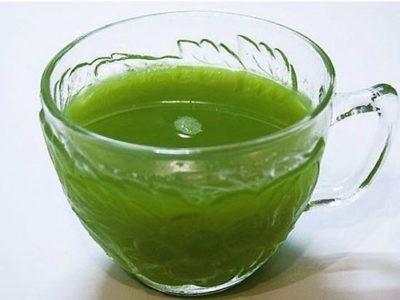

There are no clear contraindications for the use of Kalanchoe. The only thing is that it is not used to treat infants and it is also not recommended for patients with liver diseases such as hepatitis or cirrhosis.
The rest should be guided by the individuality of the organism. When taken internally, attacks of heartburn, nausea may occur, with internal and external use, allergic reactions are possible. It should not be forgotten that each organism reacts differently to certain remedies.
Don't forget to do an allergy test, before the first time to drip into the nose Kalanchoe from a cold. If you instill Kalanchoe into your nose, and you have an allergy, then you risk not only becoming covered with unpleasant red spots, but also the development of Quincke's edema.
The sap of the plant has a wide range of medicinal properties, due to which, it is used not only for the treatment of rhinitis, but also during the treatment of more serious diseases. In folk medicine, not only juice is used, but also other products prepared on the basis of Kalanchoe. You can learn more about this from our publications:
- How to prepare remedies for the treatment of sinusitis from the juice and pulp of a plant?
- What does Kalanchoe tincture treat and how to prepare it correctly?
- The healing properties of the plant and recipes for the preparation of ointments, infusions and other means from Kalanchoe.
Instructions for use
A medicinal solution is prepared from the leaves of the Kalanchoe flower at home
:
- Having collected, washed and chopped, they are placed in a garlic press.
- The gruel is transferred to cheesecloth and by slightly pressing, the juice is collected in a stainless steel dish.
- Before use, heat it in a water bath and cool to room temperature.
- After that, it is instilled into the nose with a pipette for a cold.
A runny nose in children and adults is treated differently using this medication. Children drip two drops into each nostril three times a day, and adults - 3 drops / 5 times a day. After the procedure, they sneeze, and the mucus accumulated in the nose with bacteria is removed. First, congestion disappears, and then a complete cure comes.
Does it help treat rhinitis and why?
Many people begin to suffer from colds at the onset of autumn days. Rhinitis causes particular inconvenience (we describe in detail how the plant sap can be used to treat colds in the nose and ears in this article).
However, you shouldn't run to the pharmacy for expensive drops. You can recover at home, Kalanchoe will help with this. Due to its bactericidal and antimicrobial properties, Kalanchoe is an excellent assistant in the fight against rhinitis. The composition includes either pure Kalanchoe juice or diluted with water.
Important! For children, not pure juice is used, but diluted with water. The concentrate of Kalanchoe juice itself can cause a burn of the mucous membrane. It's worth starting with one drop. Observe the manifestation of an allergic reaction.
Age restrictions
When treating a cold, it is taken into account at what age you can drip Kalanchoe juice into the child's nose. Despite its natural origin, the use of the juice of this plant in the treatment of children's rhinitis has age restrictions. In connection with the use of Kalanchoe juice for the common cold of children of different ages, there are 2 points of view:
READ ALSO: runny nose on teeth in a child: symptoms and treatment
- Pediatricians do not recommend treating babies under one year old with this remedy, since even weakly concentrated Kalanchoe juice can cause severe sneezing attacks in infants, in which bacteria enter the ear cavity from the nasopharynx.This is fraught with the development of a dangerous and difficult to treat ear disease - otitis media.
- Most experts believe that the treatment of rhinitis with Kalanchoe juice is not suitable for children under 3 years old also because of the risk of developing otitis media and allergic reactions.
Thus, a child over 3 years old can drip Kalanchoe into the nose without any serious consequences. Whether or not to use a medicine for a runny nose in each specific case is up to the child's parents in conjunction with the attending physician.
READ ALSO: is it possible to drip aloe or Kalanchoe into the nose?


Testimonials
Marina, 25 years old: I have been suffering from sinusitis for a very long time and the only thing that saved me was the Kalanchoe pinnate from the common cold. I grow the plant at home and dilute it with water in one-to-one proportions. The healing flower also helps my child a lot. An excellent inexpensive product suitable for adults and children. I advise everyone!
Olga, 32 years old: Kalanchoe plumose from a cold is an excellent, effective remedy that does not require costs. Drops of this wonderful plant cost about 70 rubles in a pharmacy, and they are enough for a long time. I often use two drops of flower juice before going to bed - the mucus disappears and the nose breathes easily all night, and in the morning it does not look swollen.
Vadim, 41 years old: My wife suggested such a folk remedy as Kalanchoe. After using the drops for four hours, the runny nose disappears, it becomes easy to breathe. An obvious plus of the medicine is that it can be used even for infants, which saves us, parents, from sleepless nights and worries about the health of our newborn daughter.
Leaf treatment
The easiest way is to use freshly cut Kalanchoe leaves. Of course, it is advisable that they soak for ten days. But if there is an urgent need, then you can use fresh raw Kalanchoe. As the reviews show, this treatment allows you to eliminate inflammatory processes.
Preparation
- The cut Kalanchoe leaf is washed with water.
- Raw materials are crushed and wrapped in clean gauze.
- The resulting compress is applied to painful areas.
How to apply
Fresh Kalanchoe gruel is used exclusively for local treatment. And before using compresses, it is imperative to test for allergies. If no negative reactions to Kalanchoe were noticed, then fresh raw materials can be used.
- Acne, boils. The compress is applied to the affected area and fixed with an adhesive plaster. This treatment continues, depending on the severity of the problem, from one to five hours. Then the compress is removed.
- Bedsores. The Kalanchoe leaf need not even be crushed. You just need to remove the skin from it and apply the juice to the bedsore. With the help of a bandage, the sheet is fixed and left overnight. During the day, the affected surface is left open. At night, a medicinal compress from the plant is again applied. Continue this therapy until the bedsore is completely eliminated.
- Diseases of the teeth and gums. Fresh Kalanchoe gruel will help reduce toothache and will be beneficial for ailments such as stomatitis, periodontal disease, and gingivitis. For this, crushed Kalanchoe is applied to the painful area. This will help strengthen loose teeth.
- Otitis. To eliminate the sudden pain in the ears, it is necessary to wrap the crushed raw materials in gauze and roll up small turundas. They are inserted into the auricles and left overnight. Turundas from the therapeutic Kalanchoe allow not only to eliminate pain discomfort, but also draw out all the pus.
- Skin diseases. A fresh Kalanchoe leaf, with the skin removed, is recommended to be applied to areas affected by eczema or psoriasis. This therapy will also help remove warts.
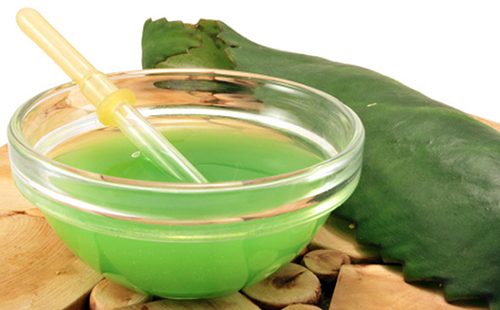

Kalanchoe in the nose: how to use the medicine?
The simplicity of the unconventional treatment method is accessible for any generation. There are enough options for making a medicinal solution.A fresh, freshly prepared composition is ideal for an effective effect.
1
First you need to select healthy leaves and rinse them thoroughly. Drying is optional.
2
The juice is preferably squeezed out through cheesecloth into a stainless steel dish. Before squeezing, it is recommended to chop the leaves;
3
For ease of use, use a regular pipette, which can be purchased at any pharmacy. The principle of action is similar to the usual drops.
4
Before using home-made drops, it is necessary to warm up the juice of the plant, then let it cool;
5
Kalanchoe juice is often used to prevent respiratory diseases. For these purposes, you can preserve a few large leaves for later use as needed. This will ensure the best preservation of the medicinal properties of the plant;
6
The most successful flower is one that has not been watered for a week. To ensure a quality healing process, an old flower with fleshy leaves and a thick layer of leaf rind is used.
Despite the unsightly appearance, it is such a stem that will benefit the body and speed up the process of treating the common cold, contributing to recovery.
to the content?
Botanical characteristic
Kalanchoe is a genus of perennials of the fatty family, which unites more than 200 varieties. In nature, these plants grow in Australia, Africa, Central America. Most of them are grown as ornamental crops. But some species have great healing power.
Common types
Studying the medicinal properties of Kalanchoe, scientists have identified several of the most valuable from a medical point of view of species. These plants easily take root on the windowsill in the apartment. They do not require specific maintenance. Large thick leaves are used as raw materials for medicinal and cosmetic purposes. The plant has three types.
- Kalanchoe is pinnate. It is this plant species that has undergone careful study. It is used in mainstream medicine for the manufacture of pharmaceuticals. Most often, when they say "medicinal Kalanchoe", they mean the feathery look. The plant can reach a height of 2 m. It has a fleshy tree-like stem with round glossy leaves. Leaf buds are formed on the teeth, providing the plant with vegetative propagation. Flowering is observed in the cold season. Large axillary panicles appear on the pedicels.
- Degremona. Another very common type of indoor Kalanchoe. Its peculiarity is the formation of children at the edges of the sheets. Such babies are very easily separated from the mother's Kalanchoe, fall to the ground and take root. Degremona usually grows up to 50 cm. Oblong leaves are distinguished by a rich green tint. Flowering occurs in the winter. The plant pleases with bell-shaped inflorescences of purple or pink color. Healers recommend using this type of Kalanchoe in folk recipes.
- Blossfeld. This type of Kalanchoe is considered the least studied. Specialist herbalists use it to make medicines. The culture has numerous stems. Blossfeld can reach a height of 30 cm. Egg-shaped leaves have a red border. The flowering of the plant begins in early winter and lasts until summer. Beautiful cluster inflorescences can delight the eye with rich orange, pink or dark red color.
Chemical composition
The main raw material for medicinal and cosmetic purposes is Kalanchoe leaves. It was in them that a unique combination of substances useful for the human body was found, as can be seen from the table.
Table - Chemical composition of Kalanchoe leaves
| Substances | Benefits for the body |
| Microelements and Macronutrients | - Improves redox processes; - stimulate hematopoiesis |
| Tannins | - Provide antimicrobial effect; - help to stop bleeding; - have an astringent effect |
| Enzymes | - Regulate metabolic processes; - stimulate chemical reactions in the body |
| Organic acids | - They have a choleretic effect; - provide a bactericidal effect; - prevent the process of decay in the digestive tract; - promote the absorption of calcium; - improve metabolism |
| Steroid substances - bufadienolides | - Stimulate the tone of the heart; - have an antitumor effect |
These beneficial substances are supplemented by vitamins, flavonoids, polysaccharides, triterpenoids and many other components that can have a therapeutic effect on the human body.
Feedback on application
Kalanchoe juice is filled with magical healing properties. Treating them with a runny nose is safe and effective. Especially when children are sick. I used to think that all this traditional medicine is complete nonsense. Now I was convinced of the effectiveness of this method of dealing with snot. For the first time I tried it on myself, then on my little daughter. Juice is made easily and simply by grating the plant leaf. Before instillation, the nose will need to be rinsed. For myself, I dripped 3-4 drops into each hole, for a child - 2 drops. Olga, 37 years old
I am a supporter of traditional medicine and am delighted with the medicinal juice of the Kalanchoe plant. It is kind of universal and helps to cope not only with the problems of smelling, but also with other ailments. Therefore, it will not be superfluous to have such a plant at home. In addition to treatment, the juice has a prophylactic effect and fights bacteria in the nasal cavity. For me, this is the most affordable, natural remedy that is easy to prepare and convenient to use. Georgy, 31
Kalanchoe drops are made from freshly prepared juice. I was cured in 2 days thanks to this drug and I am very satisfied. From some medications it happens that there are unpleasant burning sensations in the nose, passing into the throat. Also, pharmaceutical preparations have many side effects and can be addictive. The good old method of treating the common cold has no such disadvantages. And most importantly, you do not need to give a lot of money to cure the disease. After all, the best medicine will always be at your side. Tatyana, 40 years old
Drops of the medicinal plant are especially good for babies. I dripped my nose with them when I was 6 months old. The effect is felt immediately when the child starts sneezing repeatedly. Mine already on the second day felt better, and soon he was completely cured. Why is it good for children? Because it is a natural and safe product.
In addition to the fact that Kalanchoe juice treats congestion, it has magical properties that help with viral infections. By burying a baby's nose with it, you can simultaneously increase his immunity and protect him from infections. Karina, 29 years old
Kalanchoe drops are miraculous and can instantly free the nose from mucus, giving light breathing for a long time. This is a free first aid kit that will always be at your side. It seems to me that every housewife who cares about her health should have such a plant. Healing juice does not dull nasal congestion, as some drugs do, but removes all harmful mucus and bacteria from the body.
I am happy that I prefer vegetable juice to pharmacy drops and would like to recommend this tree to everyone. Svetlana Vasilievna, 46 years old
to the content?
Kalanchoe for children
Folk remedies for the treatment of various infectious viral and bacterial diseases from year to year do not lose their popularity. "Green doctors" saved more than one generation of chubby toddlers from a cold and a cough. Kalanchoe is one of those versatile plants that can help in the treatment, it seems, of any disease. Young mothers often doubt whether it is possible for children to drip Kalanchoe, and, not knowing who to ask for advice, they refuse this very effective and simple remedy.Meanwhile, official medicine has long recognized the effectiveness of this evergreen plant, not only as a treatment for an already developed disease, but also for prevention. The action of the plant is comparable to the action of expensive immunomodulators, moisturizing and restoring the protective functions of the mucous membrane of the nasal passage.
How to drip Kalanchoe to children?
To use Kalanchoe for a runny nose in children, juice should be squeezed out of it. To do this, you just need to tear off a couple of leaves and, crushing them, squeeze the juice through cheesecloth or a thin cloth, and then drip it with a pipette. If the leaf is sufficiently "fleshy" and thick, you can press on it with your fingers and squeeze the juice straight into your nose, without wasting time on chopping and filtering.
It should also be borne in mind that plants over 3 years old are considered more effective, while young shoots and leaves have a lesser effect. For those who do not want to tinker with the plant, there is an extensive selection of products on the market based on aloe and Kalanchoe juice.
But at the same time, one should not think that the treatment of a cold with the help of Kalanchoe is suitable for absolutely everyone. As with any treatment, an individual approach is important here. Kalanchoe can be used by children under one year old, but you need to focus on the child's reaction (after all, allergic reactions in babies are quite common). It is better for babies to bury the broth
Kalanchoe, one-year-old kids - juice diluted with water, while older children (from 2 years old) undiluted drops are suitable. Very young children wipe their nostrils with a cotton swab or a tampon dipped in broth, the elders are buried. This should be done 3-4 times a day.
Kalanchoe juice has one very useful effect: slightly irritating the mucous membrane, it causes sneezing, thereby clearing the nasal passages, which is especially important for children who still do not know how to blow their nose.
Before starting treatment, make sure that the child is not allergic to Kalanchoe, and consult a doctor to protect your child's health from the unwanted consequences of self-medication.
When an aqueous infusion or extract is recommended
If alcoholic tinctures are contraindicated, then it is recommended to use a water infusion of Kalanchoe. To prepare the product, you need to fill the raw materials with water and leave to infuse for ten days. But you can significantly speed up the process of preparing the infusion, but now it would be more correct to call it a decoction.
Preparation
- A crushed Kalanchoe leaf is placed in a container.
- The product is poured with water and boiled in a water bath for about 20 minutes.
- The proportions of raw materials depend on the further use. If the broth is used for local needs, then take one part of Kalanchoe and five parts of water. If the medicine is taken orally, the proportions are 1:10.
- The broth is filtered.
- To obtain an extract, the strained broth is boiled until the volume is halved.
How to apply
Taking medicine from the medicinal Kalanchoe inside is indicated for tuberculosis, pathologies of the digestive system, gynecological diseases. Drink one tablespoon before meals twice a day. The duration of therapy lasts on average a month. With tuberculosis, treatment continues for three to four months.
Local Kalanchoe broth is used to gargle. They are struggling with stomatitis, toothache. The extract or infusion can be used in cosmetology. The broth is rubbed onto the face to eliminate age spots, normalize the sebum of the dermis and cleanse it of acne. The extract is advised to use to strengthen the hair. They rinse the strands after washing.
The beneficial properties of Kalanchoe are not limited to the preparation of medicines. Herbalists say that a plant that lives peacefully on a windowsill helps cleanse the air in the room from viruses and bacteria. And according to the assurances of occult experts, Kalanchoe improves the microclimate in the family and builds relationships in the house.
Recommendations
- You should not use Kalanchoe-based products for more than 5 days. If the runny nose is without complications, then the effect will be achieved during this time. Otherwise, the treatment needs to be changed.
- If Kalanchoe does not grow in your home, then you can buy it in pharmacy juice. The cost ranges from 100 rubles per 20 ml. Read the composition carefully: it should not contain alcohol.
- The most effective way to relieve a runny nose is to bury the pure sap of the plant without additional impurities. But for children under one and a half years old, it must always be diluted in equal proportions with water.
- You can use folk recipes only after consulting a pediatrician.
Healing properties
The stems, leaves and shoots of the flower contain bioactive substances that have a complex effect on the focus of infection. The composition includes enzymes, flavonoids, macro- and microelements necessary for the body, vitamins, tannins, malic, oxalic, isolimonic and other natural acids. The healing properties of Kalanchoe with a cold are due to its multifaceted effects:
- bacteriostatic and bactericidal, which allows you to eliminate pathogenic microorganisms and stop the spread of infection;
- anti-inflammatory, vasoconstrictor, due to which the swelling of the mucous membranes decreases and nasal breathing is facilitated;
- immunomodulatory, strengthening the defenses of a weakened organism;
- local irritation of receptors with provocation for intense sneezing and coughing, which helps to remove mucus;
- regenerating, accelerating the restoration of damaged tissues.
The plant is not allergic and rarely causes side effects. A number of herbalists believe that it is permissible to use flower juice for newborns or starting from the age of three months.
Most doctors do not recommend using Kalanchoe for the treatment of runny nose in infants. There is a risk of burns to the baby's sensitive mucous membranes, and the development of allergic reactions up to Quincke's edema is also possible, which poses a danger to the baby's life.
Attacks of strong sneezing in an infant may threaten nasopharyngeal injuries and choking with mucus. Therefore, despite the positive reviews, such treatment can cause serious harm to the health of the little patient and aggravate the condition.
Making a tincture
Kalanchoe tincture on vodka was not widely used. But for the treatment of some ailments, healers are advised to resort to this particular remedy. It is sometimes recommended to fight inflammation in the mouth. But it should be remembered that such treatment for children, since the product contains alcohol, is unacceptable.
Preparation
- Kalanchoe leaves are cut into small pieces.
- The raw materials are placed in a half-liter jar, filling half the volume.
- From above, the mixture is poured with high-quality vodka to the edges of the can.
- Withstand the product for ten days, remembering to shake it periodically.
- The mixture is then filtered. Store the finished medicine in the refrigerator.
How to apply
The tincture is useful for rheumatism, gout, arthritis, radiculitis and many other pathologies of the musculoskeletal system, as well as for varicose veins, but only as a local therapy. Inside, the tincture is taken for prostatitis.
- Diseases of the joints. It is recommended to rub the affected joints with alcoholic tincture of Kalanchoe. This will reduce the severity of inflammation, relieve pain.
- Varicose veins. It is recommended to use tincture for rubbing the legs at the stage of the appearance of spider veins on the skin. In this case, the therapy will be more successful. Rubbing begins near the feet and gently moves up to the knees. With varicose veins, it is forbidden to press on the affected vessels. The duration of treatment can be extended for four months.
- Prostatitis. To defeat prostatitis, it is recommended to take the medication internally. Men are prescribed one teaspoon of the tincture 20 minutes before meals, twice a day.The therapy is continued for two weeks and a break is made for 14 days. Then the course is resumed again.
Kalanchoe tincture on alcohol is categorically contraindicated for people suffering from liver diseases and patients prone to alcoholism. It is better for such individuals to consider treatment with an aqueous infusion or juice.
What type of rhinitis and at what age is Kalanchoe used?
A runny nose is an inflammation of the nasal mucosa, accompanied by tissue edema and profuse serous-mucous discharge. It usually manifests itself in acute respiratory viral infections or allergies. It can appear at any age, including newborns.
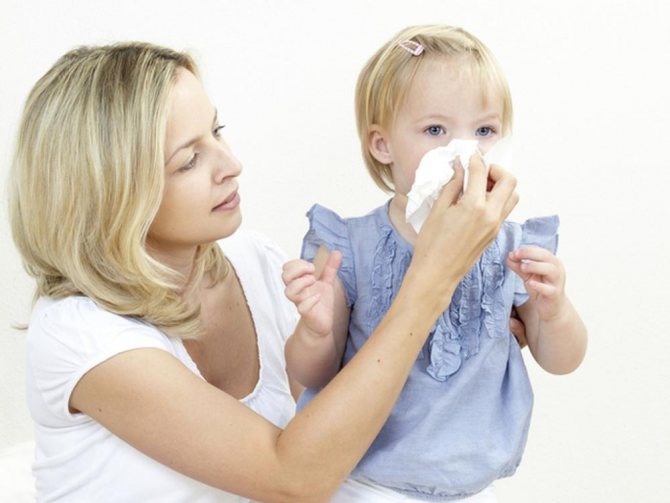

Runny nose is a common problem in childhood
If the child rubs his nose too often or makes snorting sounds, then it is necessary to take measures to treat the common cold. Otherwise, complications such as sinusitis, otitis media, ear inflammation, and loss of smell may develop.
Kalanchoe is a remedy for symptomatic treatment, that is, it helps to cleanse the baby's nose of excess mucus and has a disinfecting effect, but does not relieve a cold. Therefore, it should be used with severe airway congestion, when other means, for example, basic washing of the sinuses with saline solution or their release with an aspirator, do not work.
Important! Pseudo runny nose is very common in babies under one year old. You can distinguish it from an infectious or allergic one as follows: if the characteristic snoring disappears during the feeding period, this indicates that there is no disease and no treatment is required.
Kalanchoe remedies can even be used to treat newborns. But it is necessary to observe the correct dosage and concentration of its juice in the solution:
- up to a year, it is better to use not juice, but a decoction of leaves. It is soft enough and will not damage the delicate mucous membrane. If the baby does not allow his nose to drip, then wipe each nostril with a cotton swab;
- from a year to a year and a half, Kalanchoe juice should be diluted with boiled water;
- for children from one and a half years old and older, you can use the extract in its pure form.
Therapeutic types of Kalanchoe - photo gallery
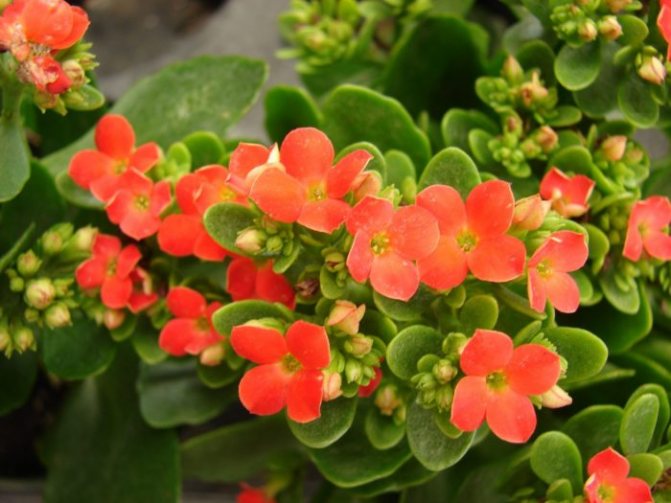

Kalanchoe Blossfeld
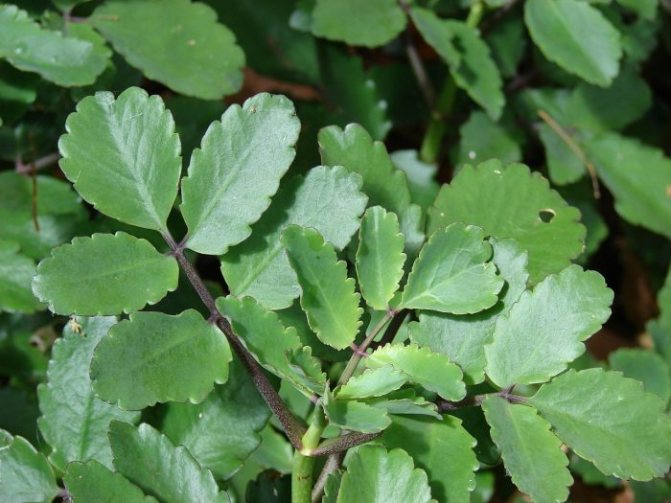

Feathery Kalanchoe (pinnata)
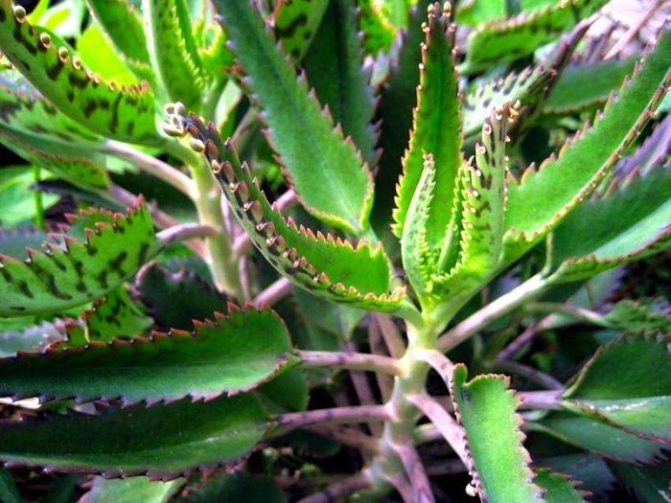

Kalanchoe Degremona
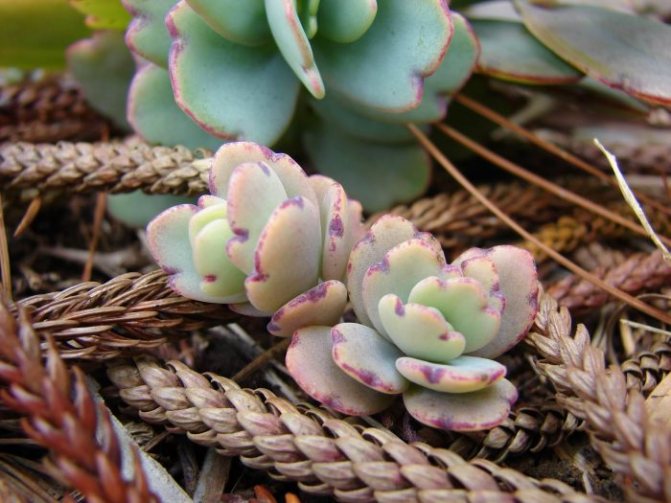

Kalanchoe Fedchenko
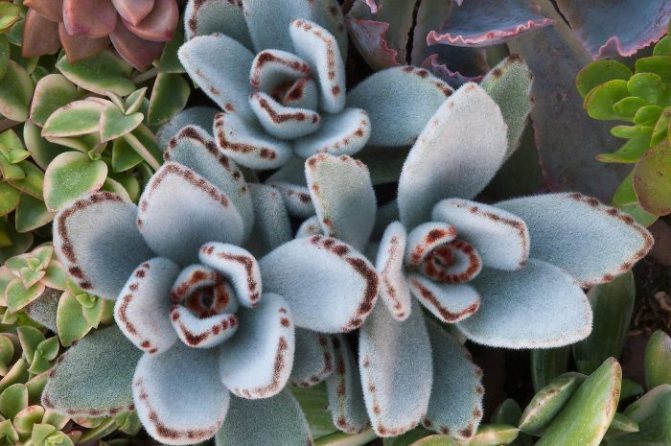

Kalanchoe Panda
Useful properties of Kalanchoe - video
What is Kalanchoe Degremona?
The genus of Kalanchoe plants originates in distant tropical countries. On the European continent, in the wild, it does not grow. Being a succulent, Kalanchoe actively accumulates large reserves of moisture in its stems and leaves, preserving it.
It is this moisture, in the end, that is used mainly for the preparation of such healing natural preparations for the common cold at home. Kalanchoe belongs to the large family of Tolstyankovye.
Kalanchoe daigremontiana - Kalanchoe Degremona, this is one of two types that can be used in folk recipes for beauty and health. This plant has many other, unofficial, names, one of which is "Goethe Flower", since this world famous poet, at one time, dedicated to him one of his winged sayings, admiring the way the plant was spread from "children" arising on his leaves (the plant reproduces by means of leaf buds).
Kalanchoe Degremona is an ornamental and, at the same time, a medicinal plant with pointed leaves, between the teeth of which "children" with roots, already ready for independent growth, develop.
The height of an adult plant is about 55 centimeters, however, it can reach much larger sizes, provided that the external environment, and its conditions, contribute to this. In nature, there are about 200 different forms (varieties) of Kalanchoe.Let's talk in more detail about two of them: already mentioned above - Degremona, and another, no less healing - Kalanchoe pinnata (Kalanchoe pinnata).
Kalanchoe from a cold - photo
If you do not know what the Kalanchoe looks like, then I suggest looking at the photo of the Kalanchoe.
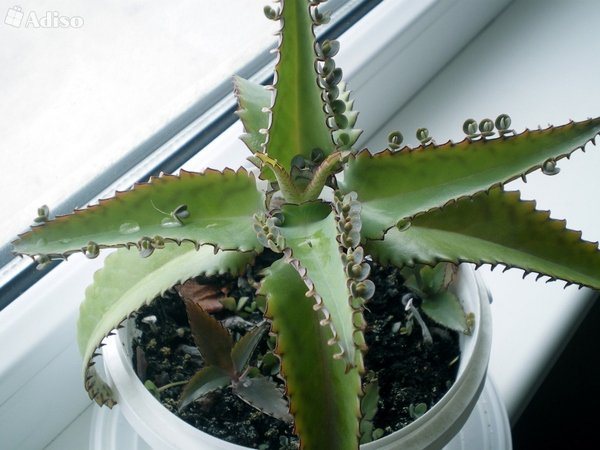

Juice and decoction preparation
If a kalonchoe grows on the windowsill at home, then it is not difficult to make a medicine. It is necessary to take a leaf from an adult plant, it is better if it is more than 3 years old. Young greenery does not yet contain the required concentration of nutrients. Although plants of any age are suitable for instilling a nose for a child.
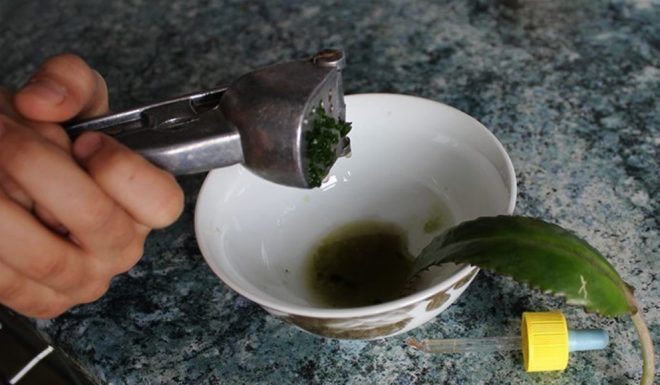

To make juice from Kalanchoe leaves, you need to prepare in advance. Experts advise to stop watering the plant in a week. In the absence of moisture, the maximum concentration of nutrients will accumulate. Healers recommend plucking the large lower leaves of the plant from a cold: 3-5 pieces are enough to prepare drops. Remember to rinse them well under running water.
If they are fleshy, then the liquid is squeezed out simply with your fingers. But it's easier to use a garlic press or grate the leaves on a fine grater. The resulting gruel should be squeezed through cheesecloth. You can store the prepared juice for up to 24 hours. Dilute it just before use.
For the treatment of newborns, it is necessary to know in advance the recipe for the decoction. The product is prepared from several leaves and 200 ml of cold water. The mixture is put on fire, brought to a boil. Turning off, let the broth brew. After cooling, the liquid can be instilled even in a newborn baby.
Chemical composition of Kalanchoe Degremon
It is rich in biologically active substances that have a positive effect on human health. So, among them there are flavonoids, tannins, bufadienolides, enzymes, lectins and numerous organic acids, enzymes (enzymes and specific proteins). They, in many respects, explain the amazing, in a positive sense, healing effect of the plant. But, no less deserved, in this aspect, are vitamins and minerals, which Kalanchoe simply abounds in.
Among the minerals it should be especially noted:
✔ Zinc (the most important of the elements of the immune system of the human body), magnesium (improves the susceptibility of soft tissues of healing substances coming to them from the Kalanchoe).
✔ Iron (accelerates metabolic processes in the nasopharynx and increases the activity of absorption of a natural drug)
✔ Manganese (has a pronounced bactericidal and antifungal effect)
✔ Potassium (participates in all processes that ensure the conduction of nerve impulses, maintains the alkaline balance of the blood, as well as fluid in the tissues, catalyzes metabolic reactions)
✔ Copper (the need for this extremely important element increases significantly in the presence of inflammatory ailments in the body, which, by the way, are often accompanied by a runny nose, being either their consequence or already the cause)
✔ Iodine (actively involved in the body's fight against "unauthorized invasion" of pathogenic microorganisms) and others. Possess the minerals listed above and many other properties that are so necessary to maintain the health of the entire body. However, only those were given here that relate directly to an aspect of our today's conversation: a runny nose.
In addition, the Kalanchoe contains other minerals, but their effect is not so significant, but it is still present.
We should not forget about the vitamin composition of this plant!
✔ Vitamin C. So, it contains a lot of vitamin C. This is a well-known "fighter" of the immune system, without which it would hardly be able to cope with even such an insignificant, in comparison with many others, a problem like the beginning of a cold.
✔ Vitamin P, acts in a highly productive tandem with its predecessor (vitamin C), as it helps not only to keep it in the body, but also enhances its properties.
✔ Vitamin K, enhancing the antiseptic and anti-inflammatory properties of Kalanchoe.
Other vitamins that actively participate in the processes of suppression of pathogenic microflora and the improvement of the nasopharynx.
The opinion of doctors about the treatment of a child with a plant
Opinions about the advisability of using Kalanchoe as a medicine for the common cold were divided.
For example, phytotherapist Tatyana Kovaleva recommends using a plant for nasal congestion. But he clarifies that for babies, Kalanchoe juice needs to be diluted with water:
Will sneeze, the nasal passages will be free. You can continue further treatment.
Dr. EO Komarovsky is more cautious about such a folk remedy. When asked by a puzzled parent, he said the following:
I come across the use of Kalanchoe regularly, but I myself do not recommend this, because the reactions are very individual. It helps some very well, but I also saw worsening. You can try in order to determine your own sensitivity, but only after the third day of ARVI. And the first three days - let him fight himself. In any case, it is better to experiment with Kalanchoe than to drip vasoconstrictor drops into the nose or test antibiotics without real reason.
But the otolaryngologist and candidate of medical sciences E.I. Kononenko approached the issue in a comprehensive manner and conducted a whole study on the properties of Kalanchoe, the results of which were later published in his blog. Referring to various sources, he concluded:
Would I advise older children to bury Kalanchoe in the nose? I will recommend Kalanchoe in some rare situations. Despite the fact that self-medication of Kalanchoe is widespread and there is no information about cases of Kalanchoe poisoning, the parents of the child should know that there is no scientific evidence of the safety of using Kalanchoe in childhood. Alternative treatment does not automatically mean safe treatment.
Would I recommend instilling Kalanchoe into the nose for infants? The answer is no.
Are there any side reactions?
There is a chance of their occurrence when using any method of treatment, product, cosmetic. It is impossible to predict them. Kalanchoe is no exception. Perhaps its irritating effect, which will manifest itself as sneezing, dryness of the nasal mucosa. Perhaps, on the contrary, the amount of mucus will increase.
Sneezing with a runny nose can be beneficial, since during such an action mucus is pushed out of the nose, even the thickest, which stagnates in its back sections. Side effects can turn into beneficial ones, especially in children who cannot blow their nose.
When treating Kalanchoe, allergic reactions are not excluded, which can manifest itself as edema of the nasal mucosa, Quincke's edema and even anaphylactic shock.
Outwardly, edema of the mucous membrane will manifest itself as difficulty breathing through the nose. Difficulty swallowing is possible. Quincke's edema is more massive. This is a life-threatening condition in which the mucous membranes increase in size to such an extent that air can no longer pass through the airways to the lungs. Most often there is laryngeal edema, or bronchospasm. The child loses his voice, begins to breathe heavily. With bronchospasm, wheezing rales are heard at a distance.
Anaphylactic reaction appears 5 to 30 minutes after the instillation of drops from the Kalanchoe. In 90% of children, skin rashes appear, which are accompanied by itching, swelling, and the appearance of mucous discharge from the nose. In 50% of babies, Quincke's edema occurs. In 20%, severe weakness and loss of consciousness are added to the above symptoms.
Itching, redness of the skin, eyes, rash, increased runny nose are the most common manifestations of Kalanchoe allergy.


First aid for allergies
The first thing to do in the event of an allergy is to immediately stop contact with the Kalanchoe. To do this, rinse the child's nose abundantly with boiled water or saline. After that, the baby should be given any antihistamine that is in the house (Fenistil, Zodak and others). It is important not to exceed the recommended dosage of the medication. During the day, the child must be monitored. In the future, any herbal preparation should be treated with caution.
If, against the background of the use of Kalanchoe juice, the child has anxiety, difficulty breathing, hoarseness, wheezing rales that are heard from a distance, such manifestations may indicate the onset of anaphylactic shock that threatens the baby's life. An ambulance must be called immediately.

